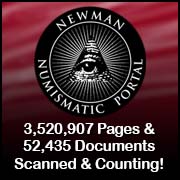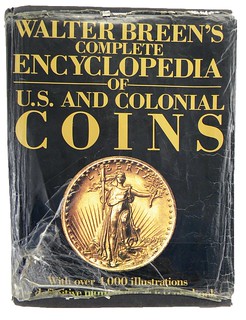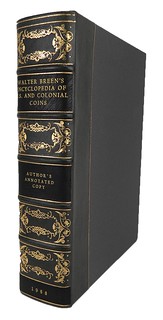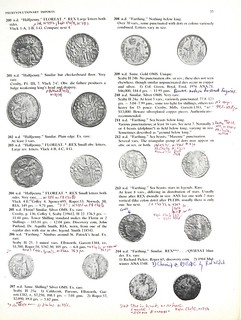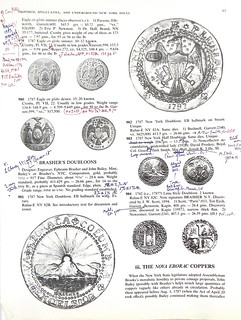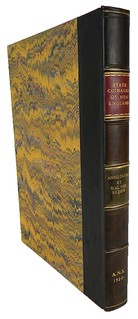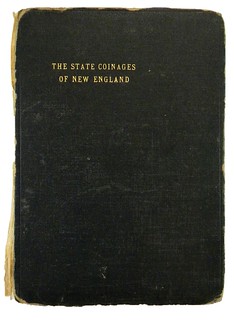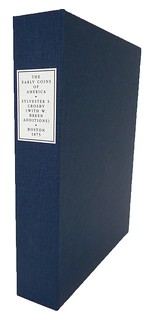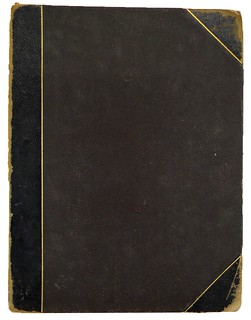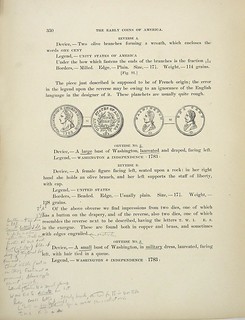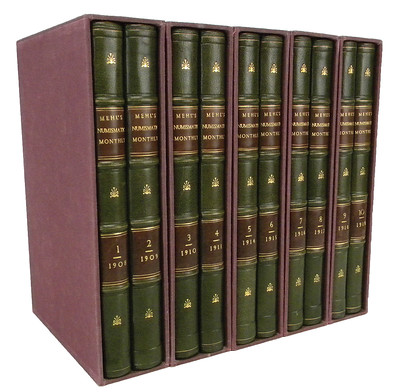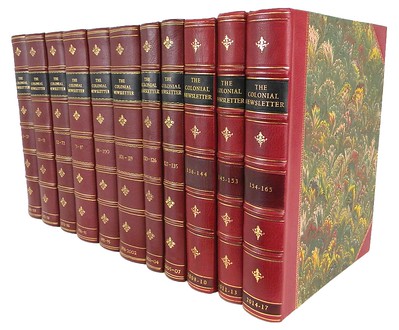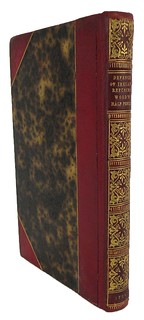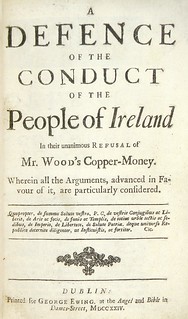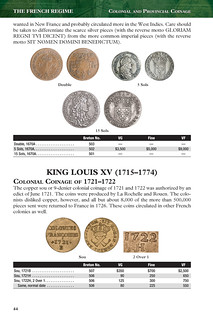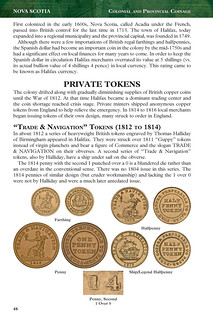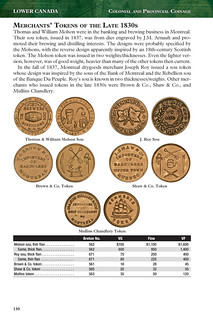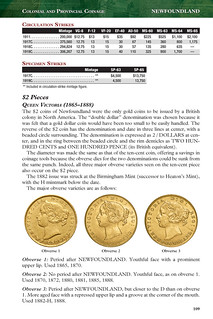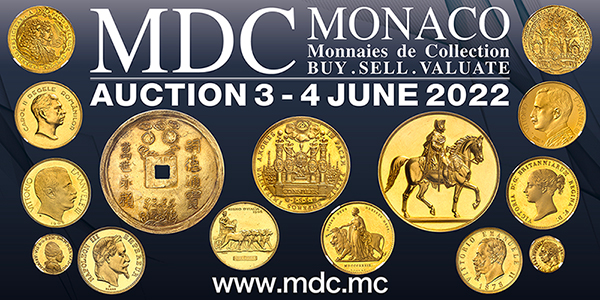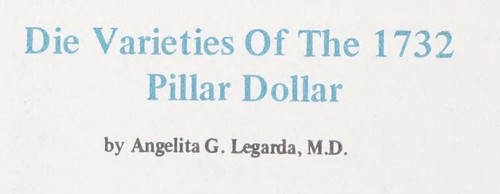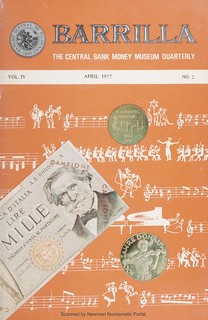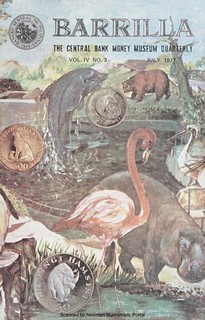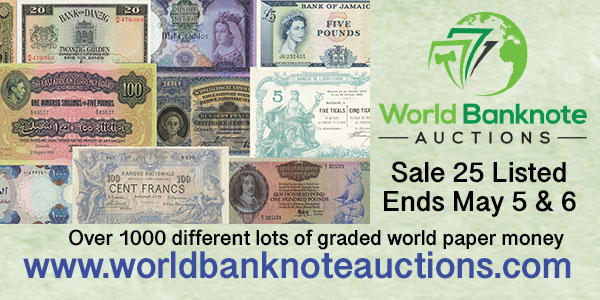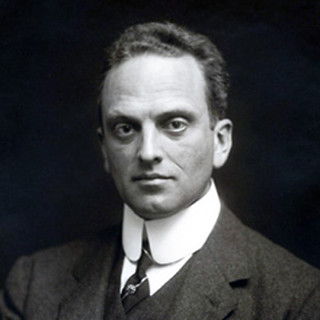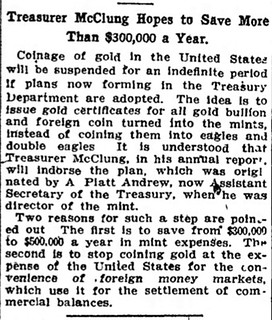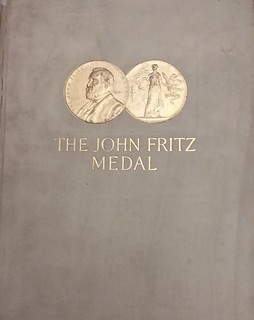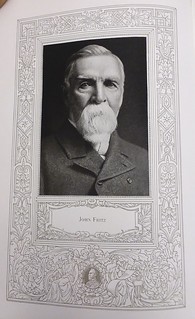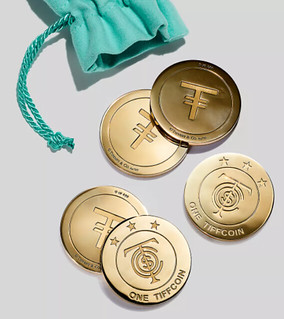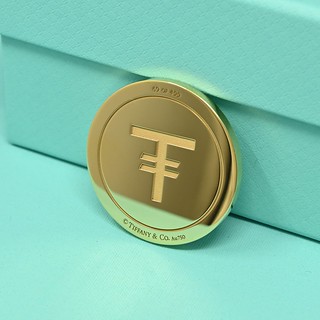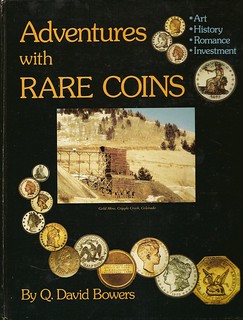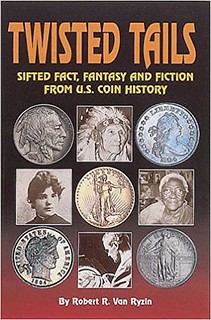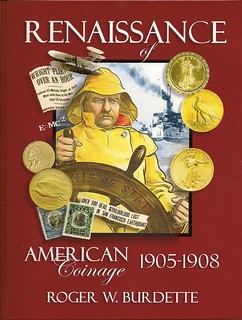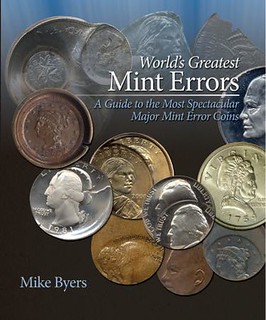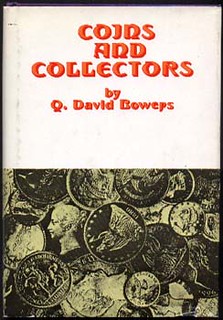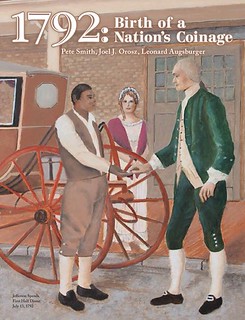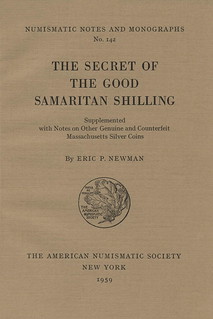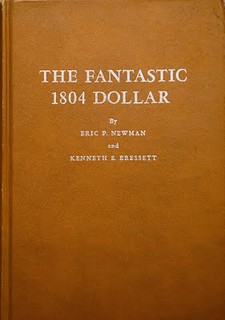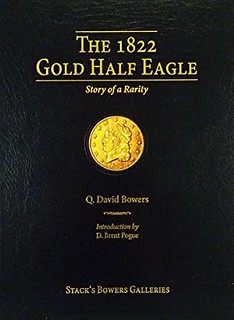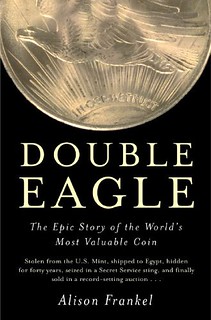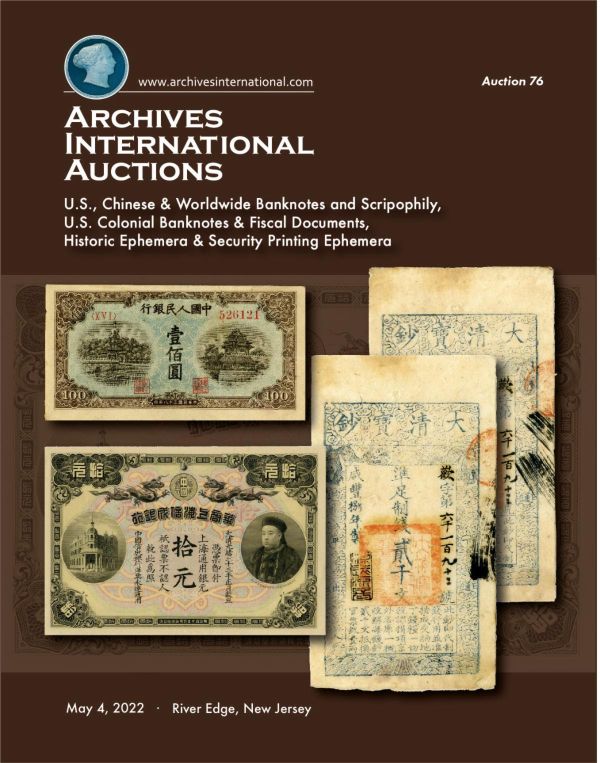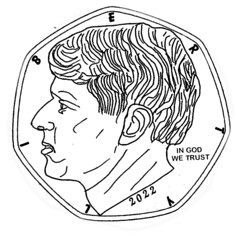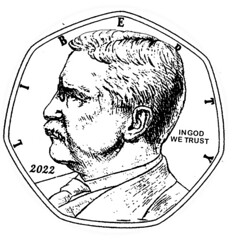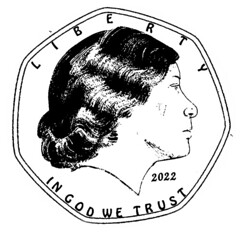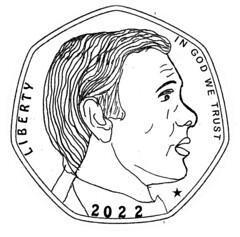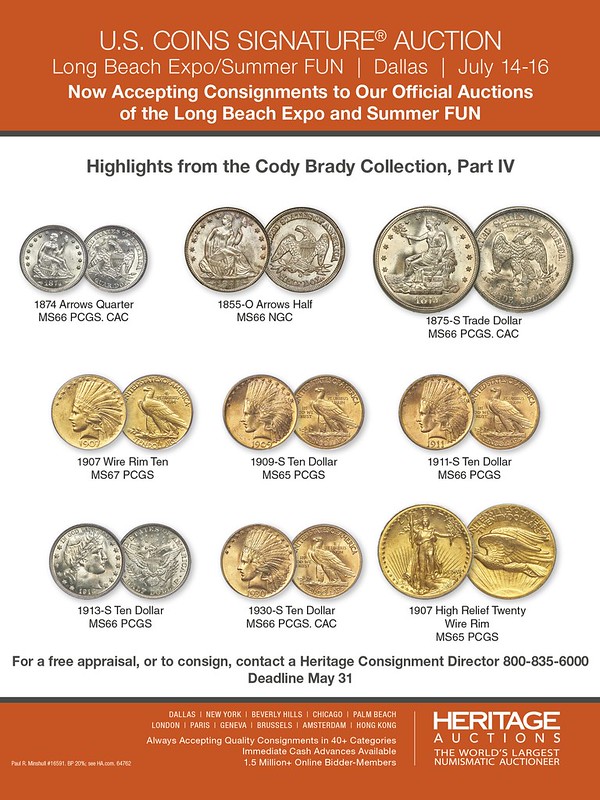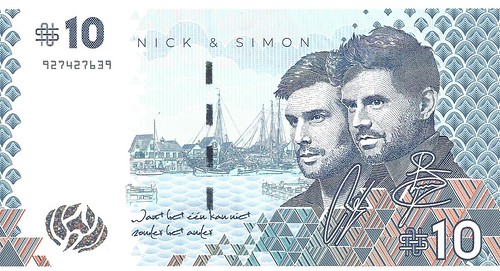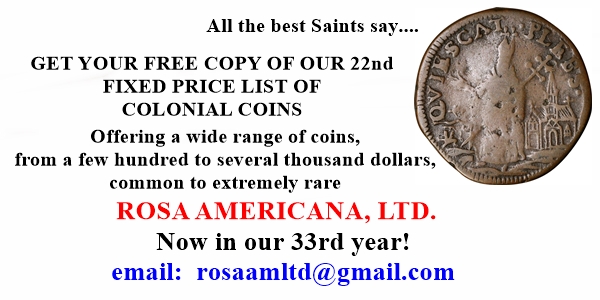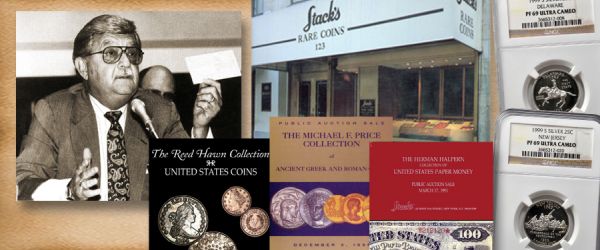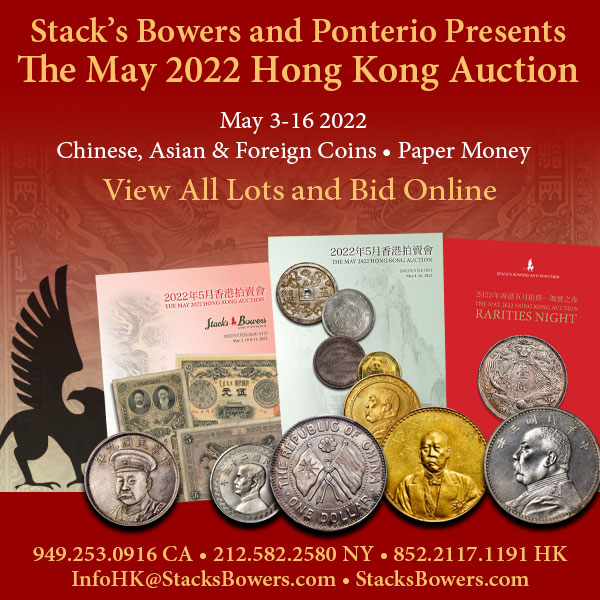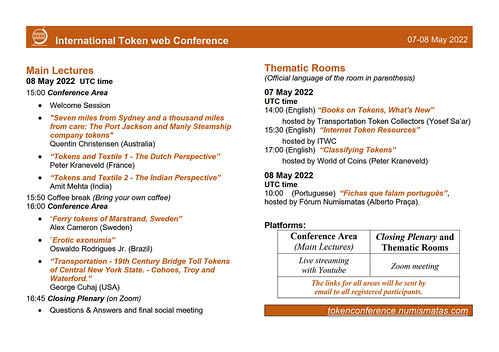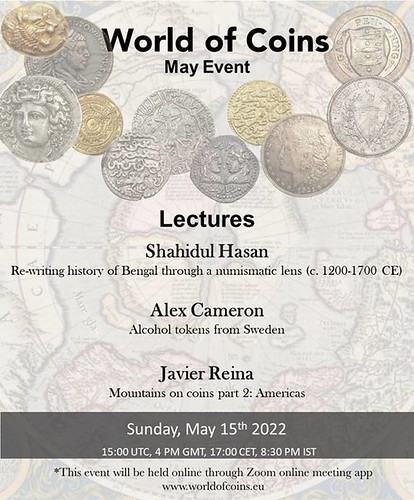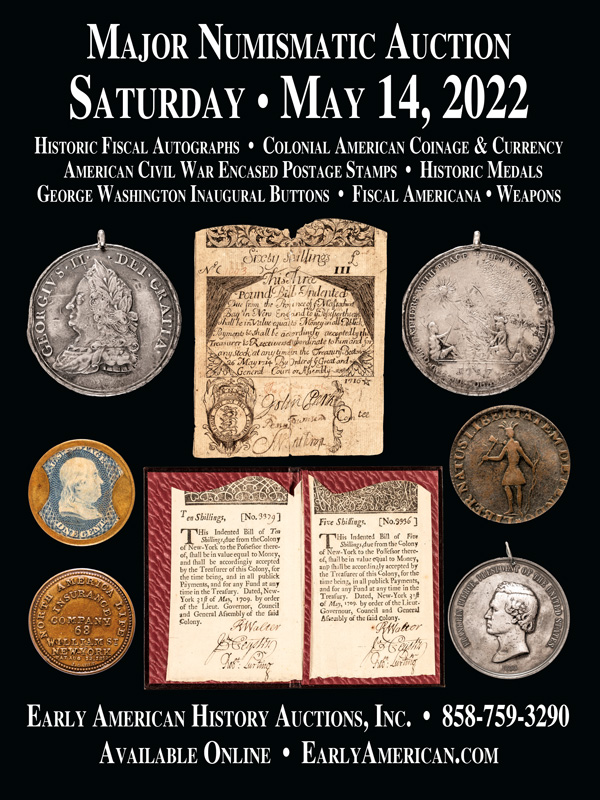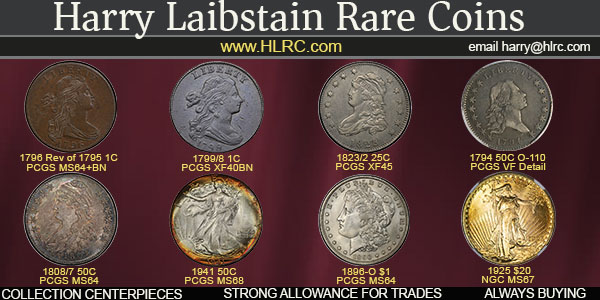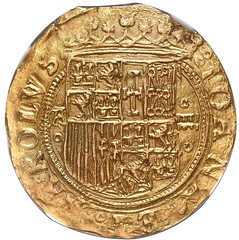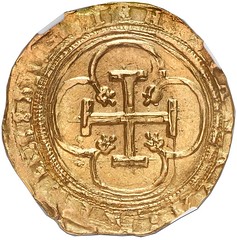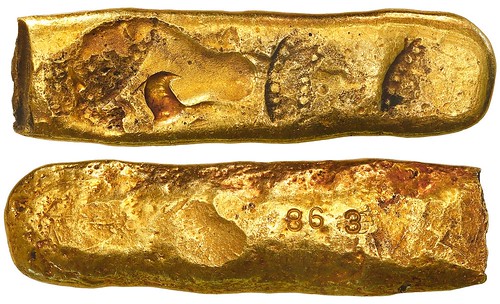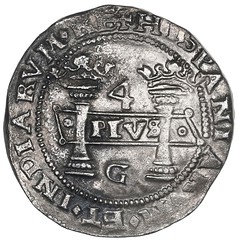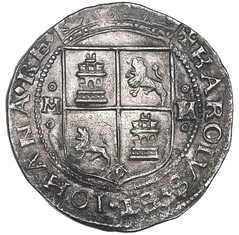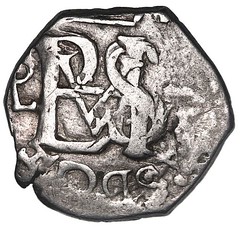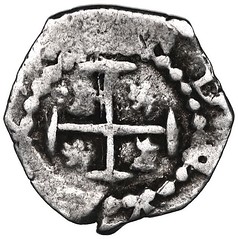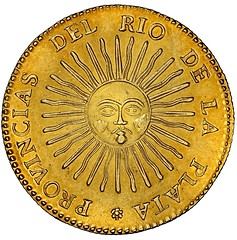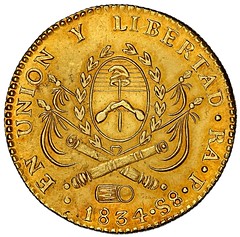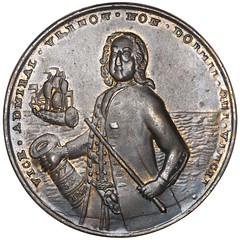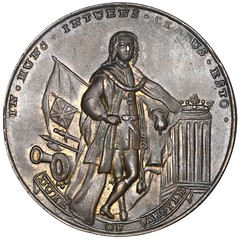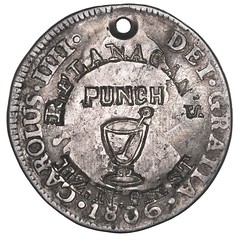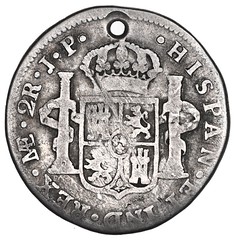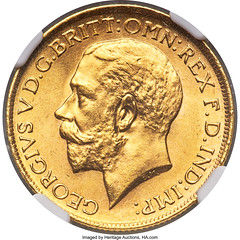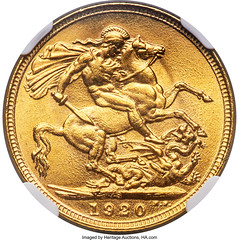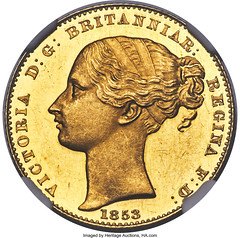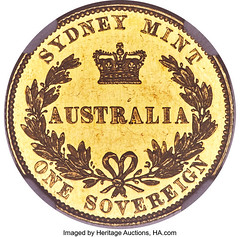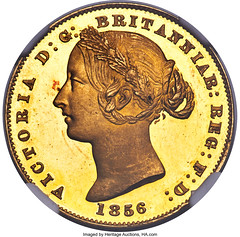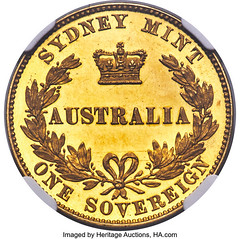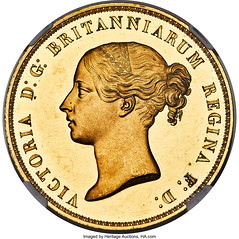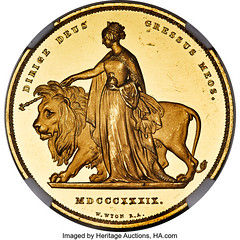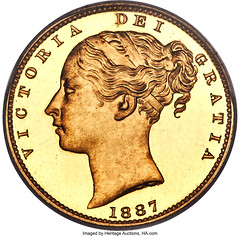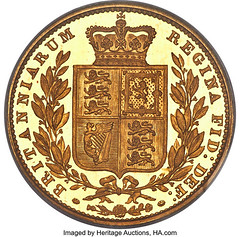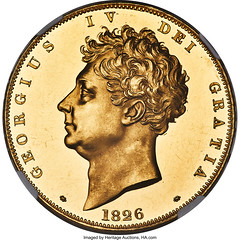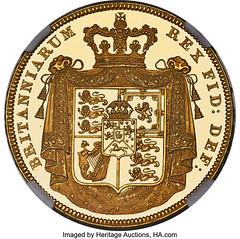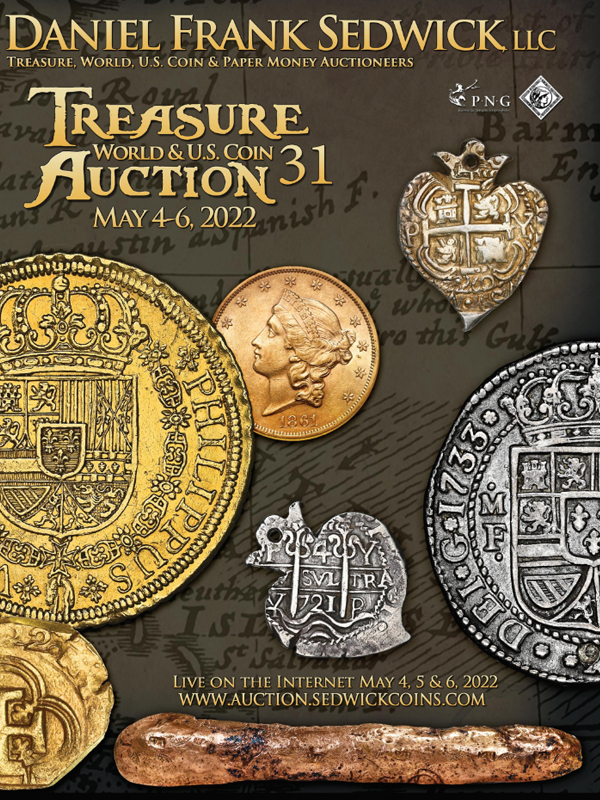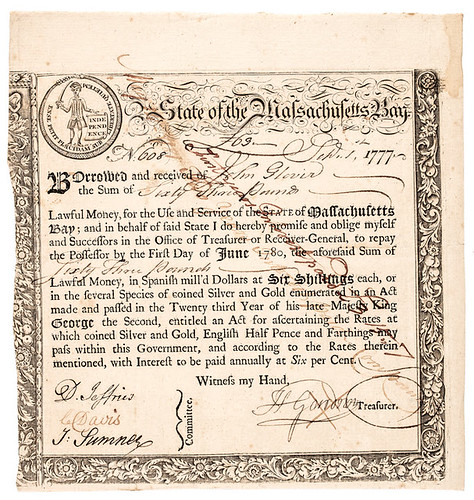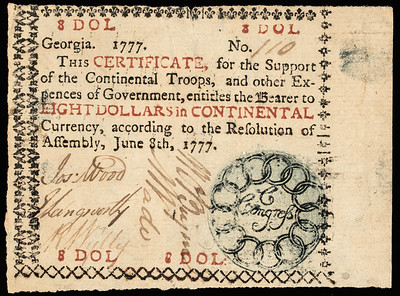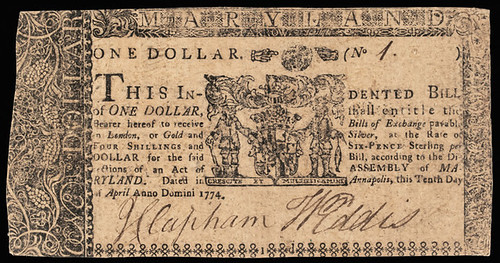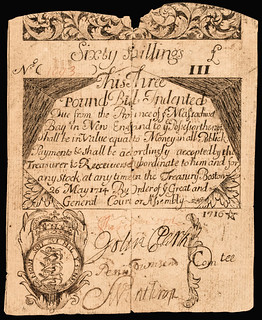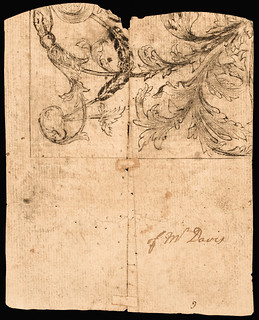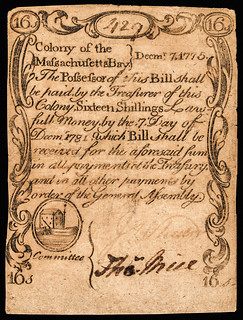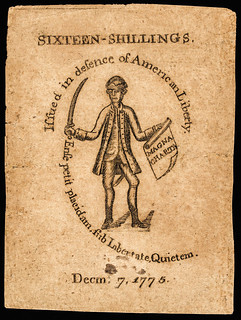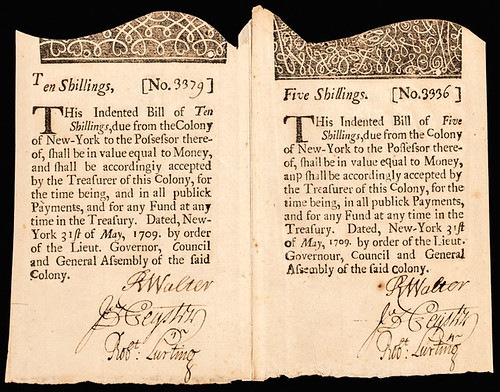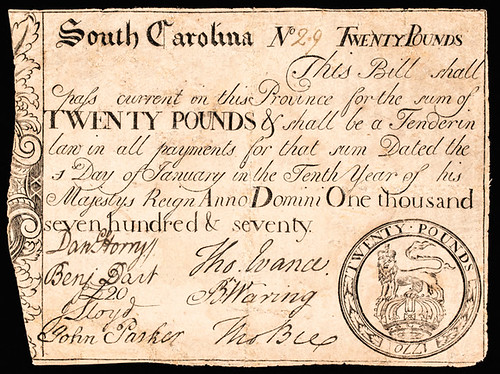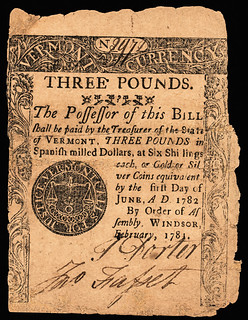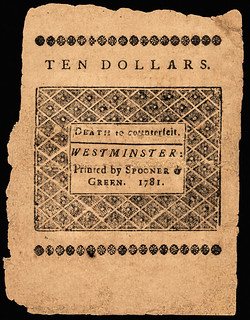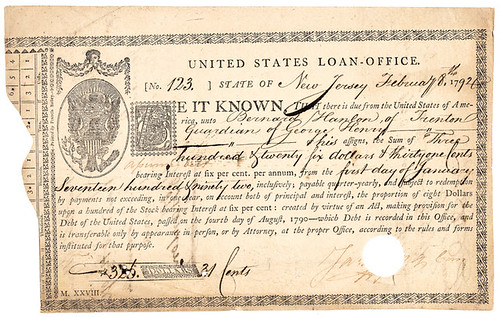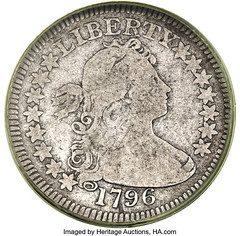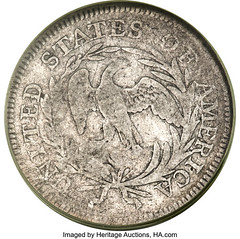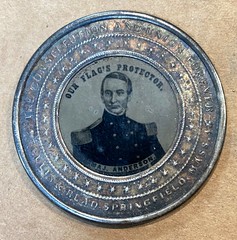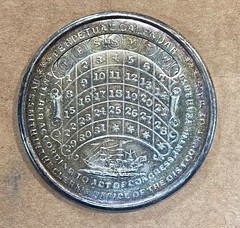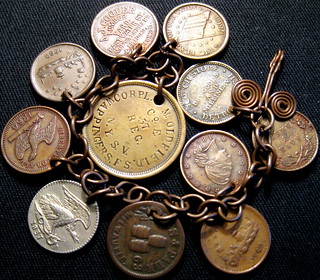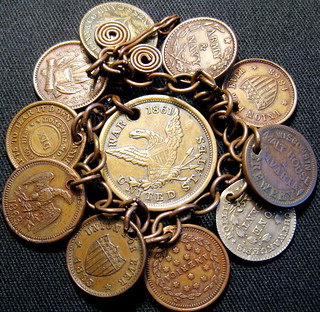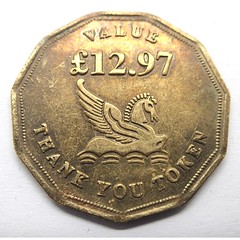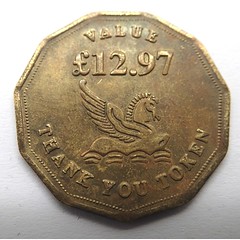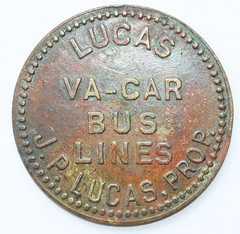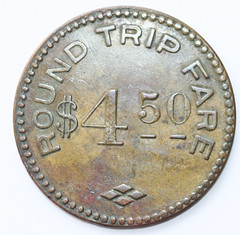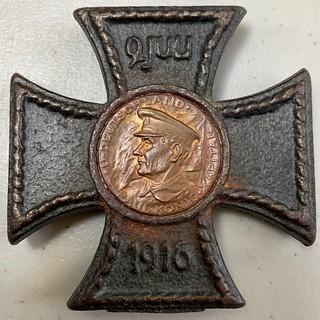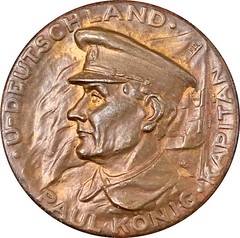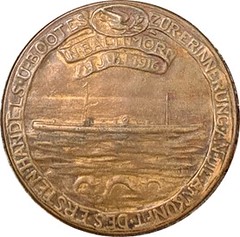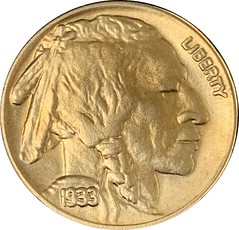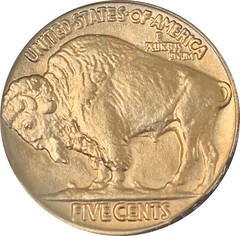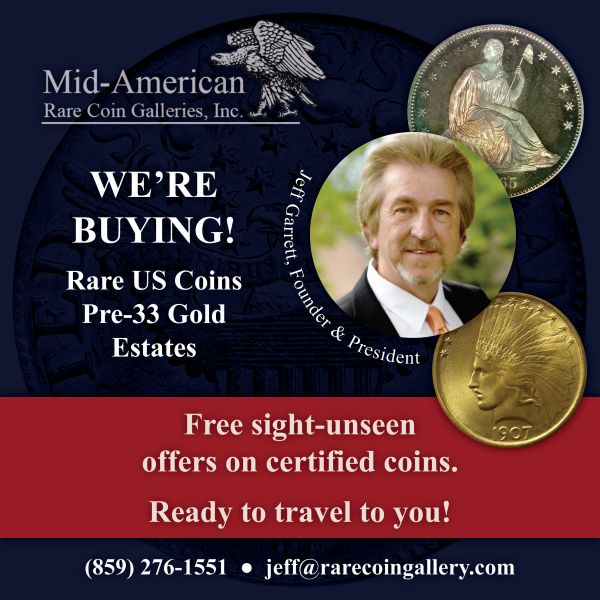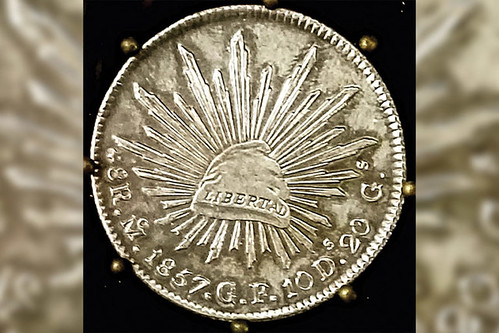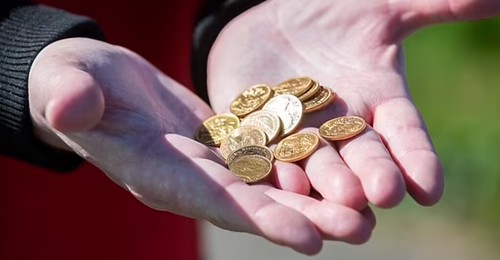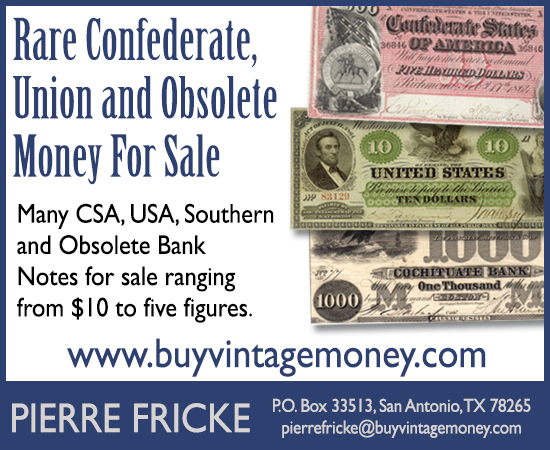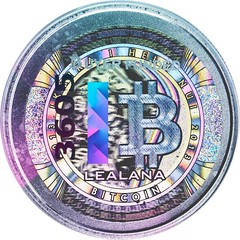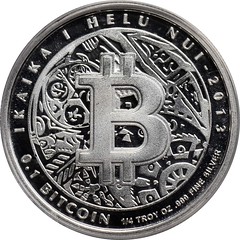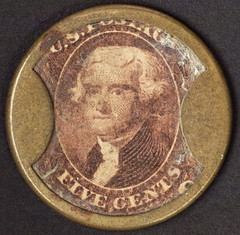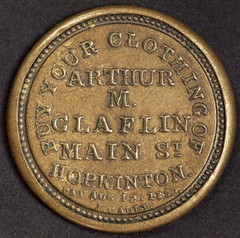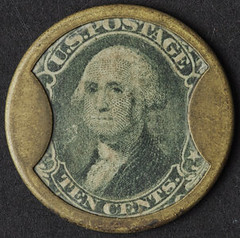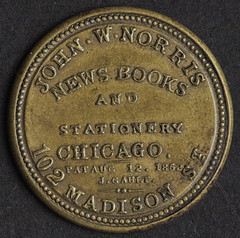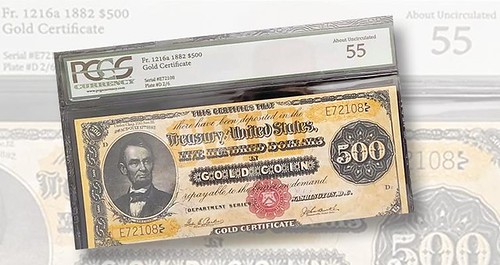
Visit our NBS Sponsors



About UsThe Numismatic Bibliomania Society is a non-profit association devoted to the study and enjoyment of numismatic literature. For more information please see our web site at coinbooks.org SubscriptionsThose wishing to become new E-Sylum subscribers (or wishing to Unsubscribe) can go to the following web page link MembershipThere is a membership application available on the web site Membership Application To join, print the application and return it with your check to the address printed on the application. Print/Digital membership is $40 to addresses in the U.S., and $60 elsewhere. A digital-only membership is available for $25. For those without web access, write to: Charles Heck, Treasurer AsylumFor Asylum mailing address changes and other membership questions, contact Chuck at this email address: treasurer@coinbooks.org SubmissionsTo submit items for publication in The E-Sylum, write to the Editor at this address: whomren@gmail.com BUY THE BOOK BEFORE THE COIN |
- WAYNE'S WORDS: THE E-SYLUM MAY 1, 2022
- KOLBE & FANNING SYD MARTIN LIBRARY RESULTS
- NEW BOOK: CORPUS OF FATIMID COINS: SUPPLEMENT
- NEW BOOK: COINS, BANKNOTES, TOKENS OF ISRAEL
- THE WHITMAN
RED BOOK
OF CANADIAN COINS - NEWMAN PORTAL ADDS BARRILLA
- VIDEO: LARGE CENT COLLECTOR JOHN SAIA
- DAVE PERKINS: THE DAY I STOPPED THE PRESS
- MORE ON GOLD COIN CIRCULATION IN THE U.S.
- NOTES FROM E-SYLUM READERS: MAY 1, 2022
- QUERY: LEGENDARY COINS
- HEPTAGONAL HALF DOLLAR DESIGN SUGGESTIONS
- AUGMENTED REALITY BANKNOTE DEBUTS
- VOCABULARY TERMS: INSCRIBE, INSCRIBING
- ROBERT BASHLOW, PART ONE
- HARVEY STACK'S NUMISMATIC FAMILY, PART 120
- UPCOMING NUMISMATIC EVENTS: MAY 1, 2022
- 2022 ANA MONEY TALKS AND SUNDMAN LECTURES
- TOP ANA AWARD NAMED FOR CHESTER L. KRAUSE
- TOP PNG AWARD NAMED FOR HARVEY G. STACK
- SEDWICK TREASURE AUCTION 31 ANNOUNCED
- SEDWICK TREASURE AUCTION 31 SELECTIONS
- HERITAGE REGENT AUSTRALIAN GOLD COLLECTION
- EARLY AMERICAN MAY 2022 AUCTION HIGHLIGHTS
- NUMISMATIC NUGGETS: MAY 1, 2022
- WAYNE'S NUMISMATIC DIARY: MAY 1, 2022
- GENERAL STEPHEN D. LEE'S CONFEDERATE COIN
- NEW PUPPY FINDS GOLD SOVEREIGN CACHE
- THE 2022 AUSTRALIAN MINT HONEYBEE COIN
- PHYSICAL CRYPTOCURRENCY PREMIUMS
- THE ENCASED POSTAGE STAMP
- NEW GUINEA HEAD TAX TOKENS
- THE S.S. REPUBLIC C.Q.D. DISTRESS SIGNAL MEDAL
- LOOSE CHANGE: MAY 1, 2022
Click here to read the thin version on the web
Click here to subscribe
Click here to access the complete archive
To comment or submit articles, reply to whomren@gmail.com
Content presented in The E-Sylum is not necessarily researched or independently fact-checked, and views expressed do not necessarily represent those of the Numismatic Bibliomania Society.
WAYNE'S WORDS: THE E-SYLUM MAY 1, 2022
 New subscribers this week include:
John Bach,
Ed Kelliher, and
James Ross.
Welcome aboard! We now have 7,001 subscribers.
New subscribers this week include:
John Bach,
Ed Kelliher, and
James Ross.
Welcome aboard! We now have 7,001 subscribers.
Ken Spindler writes: "Congratulations on making 7,000!" Thanks. At 7,001 I was reluctant to trumpet the milestone, because we regularly have 3 or 4 additions and subtractions every week. This week was no exception, and you can see where we landed again. Thanks to everyone who helped recruit new subscribers recently. Keep those email addresses coming!
Thank you for reading The E-Sylum. If you enjoy it, please send me the email addresses of friends you think may enjoy it as well and I'll send them a subscription. Contact me at whomren@gmail.com anytime regarding your subscription, or questions, comments or suggestions about our content.
This week we open with results of the Syd Martin numismatic library sale, two new books (and three more in the works), updates from the Newman Numismatic Portal, half dollar design suggestions, and more.
Other topics this week include the "Red Book" of Canadian coins, gold coin circulation in the U.S., an augmented reality banknote, Robert Bashlow, John Whitney Walter, upcoming world numismatic events, the Chester Krause and Harvey Stack awards, auction previews, Australian gold, encased postage stamps, physical cryptocurrency, and New Guinea head tax tokens.
To learn more about Fatimid coins, Israeli coins, tokens and banknotes, Barrilla, the John Fritz medal, Tiffany's TiffCoins, creating the Statehood Quarters, a gold "finger" bar, Admiral Vernon medals, Flanagan's Punch, the Paul Revere Sword in Hand note, Confederate General Stephen D. Lee's David Flight dollar, Australia's honey bee coin, heptagons, hendecagons, and secret marks on coins, read on. Have a great week, everyone!
Wayne Homren
Editor, The E-Sylum
KOLBE & FANNING SYD MARTIN LIBRARY RESULTS
Here's a press release with impressive results from yesterday's Kolbe & Fanning sale of the Syd Martin numismatic library. -Editor
On Saturday, Kolbe & Fanning Numismatic Booksellers sold at auction the outstanding numismatic library formed by ANS President Syd Martin in what proved to be an exciting and memorable event. Prices across the board were generally very strong, and a number of record prices were realized for individual items. Some particularly notable results include the following (prices here quoted do not include the 20% premium):
Lot 64: Walter Breen's personal, annotated copy of his 1988 Complete Encyclopedia, estimated at $5,000, opened to bidders watching the live online sale for an amazing $30,000, before a few additional bids drove the price up to $37,500 hammer
Lot 270: Breen's extraordinarily annotated copy of Miller & Ryder on the state copper coinages, described as one of the true gems of the Syd Martin Library, sold for $27,500
Lot 138: continuing the interest in Breen-annotated volumes, the copy of Crosby's Early Coins of America annotated by him had three bidders active above the $10,000 mark before closing at $14,000
Lot 264: an exquisitely bound complete set of Mehl's Numismatic Monthly was the subject of a fierce bidding war between two determined collectors before closing at $14,000
Lot 131: another beautifully bound set, this time of The Colonial Newsletter, also received heavy bidding and brought $10,000
Lot 168: Charles Bushnell's copy of George Ewing's 1724 Defence of the Conduct of the People of Ireland, one of the most important and rarest of the attacks on the William Wood coinage, sold for $10,000
More than ten lots closed at $10,000 or higher, with enormous interest shown in the Breen material, rare publications on colonial coins, exceptional bindings, and archival materials. Many items estimated in the hundreds brought prices in the thousands, and the sell rate was well over 90%. It was a truly memorable occasion, and a testimony to the care with which Syd Martin had developed his library over the years. He cared deeply for his books, and it was gratifying to see that this respect was shared by many others.
We want to thank everyone who participated in the sale and who helped make it happen. A full prices realized list will be posted to the Kolbe & Fanning website at numislit.com. Our next sale is tentatively scheduled for August—more on that later!
To read the earlier E-Sylum articles, see:
KOLBE & FANNING SYD MARTIN LIBRARY SALE
(https://www.coinbooks.org/v25/esylum_v25n14a02.html)
KOLBE & FANNING SYD MARTIN LIBRARY SELECTIONS
(https://www.coinbooks.org/v25/esylum_v25n15a02.html)
MORE SYD MARTIN LIBRARY SELECTIONS
(https://www.coinbooks.org/v25/esylum_v25n16a02.html)
SOME MORE SYD MARTIN LIBRARY SELECTIONS
(https://www.coinbooks.org/v25/esylum_v25n17a02.html)
NEW BOOK: CORPUS OF FATIMID COINS: SUPPLEMENT
Stephen Album Rare Coins has published a Supplement to Norman Douglas Nicol's 2006 publication on Fatimid Coins. -Editor
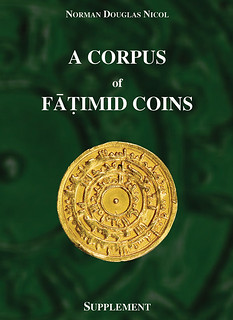 A Corpus of Fatimid Coins: Supplement
A Corpus of Fatimid Coins: Supplement
Nicol, Norman Douglas
Santa Rosa, 2021, 56 pages, 10 plates, softcover.
A wonderful addition to the original 2006 publication with this supplement covering those coins not included in the original work. Includes approximately 400 new listings with ten plates of high quality black and white images.
SARC Item No. 282646
Price: $30 USD
USA Shipping (USPS Media Mail): $5 USD
International Shipping (First-Class Mail): $25 USD
Shipping rates are for 1 copy only. To inquire about rates for multiple copies please contact us. (Limit 3 copies per person).
To purchase a copy send an email to: info@stevealbum.com
For more information, or to order, see:
A Corpus of Fatimid Coins - Supplement
(https://db.stevealbum.com/php/fatimidsupplement.php)
NEW BOOK: COINS, BANKNOTES, TOKENS OF ISRAEL
An article by Hans Ludwig Grabowski on the Geldsheine Online site describes a new book on the coins, banknotes and tokens of Israel. Here's a Google-translated version. -Editor
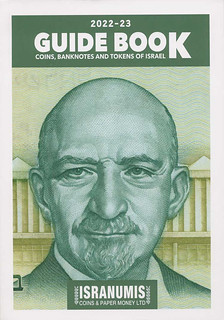 Israel Asher:
Israel Asher:
Guide Book – Coins, Banknotes and Tokens of Israel 2022/23
224 pages, illustrated in color throughout,
Format 16.5 cm x 23.7 cm, paperback, Isranumis 2022,
Price: 25.00 euros.
Without ISBN.
In the new bilingual (Hebrew and English) catalog and price guide on the Israeli coins and banknotes, those of the State of Israel and the British Mandate of Palestine and primary trademarks from the preceding period of Ottoman rule to the present are extensively described including variants, illustrated in color and in US - valued in dollars.
As both Hebrew and Arabic books are read from back to front, the catalog begins with the Hebrew title with the coins under the British Mandate from 1927 to 1948, followed by those of the State of Israel from 1948 in the various currencies. Samples and incorrect embossing are then also listed.
The coin catalog concludes with a table of all commemorative coins issued by the State of Israel from 1958 to 2001. The coin section covers just over a hundred pages and is followed by the catalog section on paper money. This begins with the rare checks from the Anglo-Palestine Company from 1914, followed by the extremely rare and highly sought-after issues from the British Mandate of Palestine from 1927, including forgeries and also rare emergency issues. The last issues under British mandate were those of the Anglo-Palestine Bank from 1948. This is followed by Israel's paper money including sample certificates and cataloging of sheet parts. The paper money part comes in almost 100 book pages. The end or the beginning - depending on which title you open the catalog from - form so-called tokens (substitute money from trading companies),
As a concordance to our own cataloging, the catalog numbers are listed according to the well-known Krause catalogs "World Coins" and "World Paper Money" as well as to Sylvia Haffner (Judaic Tokens) and Owen W. Linzmayer (The Banknote Book).
Anyone interested in the testimonies of Israeli monetary history cannot ignore Israel Asher's highly recommended new catalogue.
Please contact directly via: www.isranumis.com, E-mail: isranumis@yahoo.com.
To read the complete article, see:
Asher: Guide Book – Coins, Banknotes and Tokens of Israel 2022/23
(https://www.geldscheine-online.com/post/asher-guide-book-coins-banknotes-and-tokens-of-israel-2022-23)
THE WHITMAN RED BOOK
OF CANADIAN COINS
Last week David Gladfelter kicked off an email discussion of the Whitman Red Book of Canadian coins with a note to Howard R. Engel of Richard Stockley Books. -Editor
David wrote:
"Howard, what do you know about the so-called Whitman Red Book
of Canadian coins, by James A. Haxby? The first edition
came out in 2012 at $20 but there seem to have been no others. The Unitrade Press guide by Haxby & Willey continues to come out annually and so does the Charlton guide. What happened to the Whitman version? I see it advertised for >$100 U.S. – that's the first edition
. Strange."
Howard wrote:
"Thanks for your intriguing inquiry. As it turns out, I know precious little about this particular Haxby publication on Canadian decimal coins. In fact, it is quite apparent to me from your question that you already know that much more about it than I do. That said, is this an accurate, more detailed description of it:
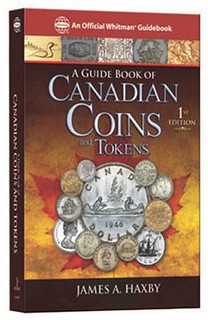 "Haxby, James A. A GUIDE BOOK OF CANADIAN COINS AND TOKENS. First edition. Whitman: Atlanta, 2012. 8vo, original pictorial boards. 461, (3) pages; illustrated in color?
"Haxby, James A. A GUIDE BOOK OF CANADIAN COINS AND TOKENS. First edition. Whitman: Atlanta, 2012. 8vo, original pictorial boards. 461, (3) pages; illustrated in color?
"Consequently, I'm copying this message to a few numismatic friends of mine (and some are no doubt likewise numismatic friends of yours as well). I'm hoping at least one or more of them may well be able to shed some light on this question. Interestingly, 3 are from the Canadian author side (i.e. Alan, Dan and Darryl) while the other 3 are from the U.S. publisher side (i.e. Joel, Len and Wayne). I trust that one or more of them would be so kind as to enlighten the rest of us who may not already know much about this particular Haxby work."
In addition to me, Howard contacted Alan Roy, Dan Gosling, Darryl Atchison, Joel Orosz, and Len Augsburger. I went straight to the source and immediately passed the question to Dennis Tucker of Whitman Publishing. -Editor
Dennis wrote:
"Thank you for your interest in this book. David is correct, we published the 1st edition in 2012, and the 2nd edition is a work in progress."
Dennis kindly provided sample pages from the upcoming book. -Editor
Dennis adds:
"This hasn't been publicized yet, but later this year we'll be releasing 100 Greatest Canadian Coins and Tokens, a richly illustrated new coffee-table book sure to delight every collector and historian. The author is Dr. Harvey Richer, whose volume on the gold coins of Newfoundland you might be familiar with."
Canadian Numismatic Bibliography editor Darryl Atchison wrote:
"I wasn't aware of this book at all since it was published after the Canadian Numismatic Bibliography came out in 2007 and I often miss new publications from that side of the pond!
"I would love to get my hands on a copy to review for an update of the CNB that I am currently working on."
That's all great news! We can all look forward to some new numismatic books in the near and farther future:
- Haxby, James A., A Guide Book of Canadian Coins and Tokens, Second edition.
- Richer, Harvey, 100 Greatest Canadian Coins and Tokens, First edition
- Atchison, Darryl, Canadian Numismatic Bibliography, Second edition
To read the earlier E-Sylum article, see:
NEW BOOK: THE GUIDE BOOK OF CANADIAN COINS AND TOKENS
(https://www.coinbooks.org/esylum_v15n05a04.html)
BOOK REVIEW: THE GUIDE BOOK OF CANADIAN COINS AND TOKENS
(https://www.coinbooks.org/esylum_v15n08a03.html)
BOOK REVIEW: A GUIDE BOOK OF CANADIAN COINS AND TOKENS
(https://www.coinbooks.org/esylum_v15n15a04.html)
NEWMAN PORTAL ADDS BARRILLA
The latest addition to the Newman Numismatic Portal is Barrilla, an important periodical on Philippine numismatics. Project Coordinator Len Augsburger provided the following report. -Editor
Newman Portal Adds Barrilla
The Philippine Central Bank Money Museum issued Barrilla, a quarterly periodical, from 1974 to 1989, with the cooperation of the Philippine Numismatic and Antiquarian Society. The journal is primarily dedicated to Philippine Numismatics and includes occasional American content. The April 1977 issue, for example, presented Die Varieties of the 1732 Pillar Dollar,
by Angelita L. Legarda.
The entire run of this periodical is now available via Newman Portal. Many thanks to Ken Berger, for loaning his set of Barrilla for scanning, and to Deputy Director Regina Mercedes C. Cruz, of the Bangko Sentral ng Pilipinas, for facilitating access to this publication.
Link to Barrilla on Newman Portal:
https://nnp.wustl.edu/library/publisherdetail/543561
VIDEO: LARGE CENT COLLECTOR JOHN SAIA
These are selections from the David Lisot Video Library that feature news and personalities from the world of coin collecting. David has been attending coin conventions since 1972 and began videotaping in 1985. The Newman Numismatic Portal now lists all David's videos on their website at:
https://nnp.wustl.edu/library/multimediadetail/522852
Here's an interview with Large Cent collector John Saia. -Editor
Coin Collector Brings Rare Pattern Large Cent to Whitman Coin Expo
VIDEO: 4:00.
John Saia, Coin Collector, Facebook; Numismatica,
David Lisot, Interviewer, CoinTelevision.com.
April 1, 2022.
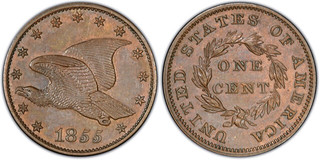 Going to a coin convention allows you to talk to other collectors and share their interests. The best way to learn about numismatics is to share with others. Coin collector John Saia talks about a rare pattern large cent and why he comes to the Whitman Expo.
Going to a coin convention allows you to talk to other collectors and share their interests. The best way to learn about numismatics is to share with others. Coin collector John Saia talks about a rare pattern large cent and why he comes to the Whitman Expo.
David adds:
"The Whitman Expo is the most important coin convention on the East Coast. Held three time a year it attracts collectors and dealers who want to do business. This collector collects large cents and enjoys CoinTelevision too!"
An excerpt of the video is available for viewing on the Coin Television YouTube Channel at:
https://youtu.be/4eGnuYi_vXo
DAVE PERKINS: THE DAY I STOPPED THE PRESS
With permission, we're republishing an article by NBS Board member W. David Perkins. Dave's piece on correcting errors in the first printing of the 1999 edition of Jules Reiver's early silver dollars book was originally published in the March 2022 issue of the John Reich Journal, the official publication of the John Reich Collectors Society. -Editor
The Day I Stopped the Press
By W. David Perkins, NLG
At some point in time Russ Logan sent me a package. Included was an e-mail note exchange between Russ and I dated Wednesday April 21, 1999.
Subject: Re: Jules Book
David:
Save all your notes, e-mails and correspondence on Jules' book in a safe place.
In fifteen years, they will make a great article!
Best……………………………………………………Russ
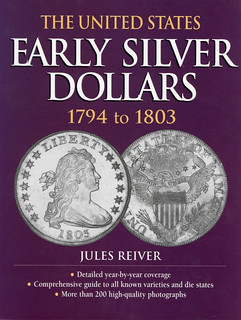
Jules' book
was THE UNITED STATES EARLY SILVER DOLLARS 1794 to 1803 published by Krause Publications (1999). This book was to take the place of Milferd H. Bolender's THE UNITED STATES EARLY SILVER DOLLARS from 1794 to 1803 which had been first published in 1950.
Sorry Russ, this article is about 8 years late but here is the story.
Jules had updated the Bolender silver dollar book over the years for Krause Publications, primarily with changes in the rarity ratings and the addition of any new early dollar die marriages. Krause and Jules were jointly working on a new book to be published under Jules' name.
Both Krause and Jules were pushing hard to get the book published as soon as possible. Jules took all the photos from coins in his collection of early dollars by die marriage and die state and sent them to Krause for publication in the book.
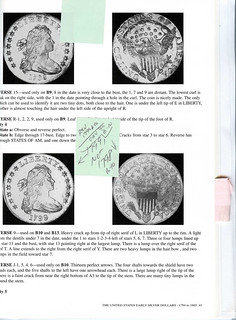 I was a contributor to the book but was not given a chance to review it before publication. I'm not sure if Jules was asked to review it either (?).
I was a contributor to the book but was not given a chance to review it before publication. I'm not sure if Jules was asked to review it either (?).
On March 3, 1999 I received a few copies of the book from the publisher. It didn't take long to realize there were MAJOR PROBLEMS. I first spotted a 1799 B-10 Dollar mixed in with the 1798s. I quickly found other incorrect plate coins. I worked from home at the time and took a little time off
that afternoon to go through the book and attributed every plate coin. According to my notes I found 20 incorrect plate photos.
I immediately notified the editor and suggested she may want to Stop the Press!
In reality, it was too late as boxes of the books had already been shipped to distributors. I learned this when our JRCS President and Editor called me and asked what was going on. He had received the books he'd ordered from his distributor who was asking for the books to be returned.
The copies printed prior to the errors being discovered have the copyright listed as:
Jules Reiver
Krause Publications
Much of March 1999 was spent correcting the plates and book. I sent a list of the errors and corrections and in April 1999 the corrected book was published and distributed. I have an original copy with errors and my correspondence with the Editor of the book.
The copies printed after the recall and corrections have 2nd Printing
added, as follows:
© 1999 by
Jules Reiver
Krause Publications
Image: Page 41 from the first printing of the Reiver Book. The 1799 B-10 Dollar is clearly out of sequence and is surrounded by 1798s.
For more information on the John Reich Collectors Society, see:
https://www.jrcs.org/
MORE ON GOLD COIN CIRCULATION IN THE U.S.
Douglas Ward submitted this piece in response to the ‘Gold Coin Circulation' item in the April 17, 2022 E-Sylum. Thanks! -Editor
A figure of historical numismatic consequence seemed to have first proposed halting the coining of gold in 1910. Abram Piatt Andrew had been Assistant Treasury Secretary only a few months when his proposal was picked up in The Washington Post on Sept. 3rd, 1910;
Coinage of gold in the United States will be suspended for an indefinite period if plans now forming in the Treasury Department are adopted. The idea is to issue gold certificates for all gold bullion and foreign coin turned into the mints, instead of coining them into eagles and double eagles. It is understood that Treasurer McClung, in his annual report will indorse the plan, which was originated by A. Piatt Andrew, now Assistant Secretary of the Treasury, when he was director of the mint.
Two reasons for such a step are pointed out. The first is to save from $300,000 to $500,000 a year in mint expenses. The second is to stop coining gold at the expense of the United States for the convenience of foreign money markets, which use it for settlement of commercial balances.
During his tenure as Mint Director, October 1909 to June 1910, Dr. Andrew earned the wrath of many numismatists that reverberates to this day. As part of a negotiated settlement with William H. Woodin, he ordered the destruction of nearly all pattern dies and hubs at the Philadelphia Mint – a great historical and artistic loss. Some of his lesser known accomplishments include the following: As a Harvard Associate Professor he had predicted the banking panic of 1907, which lead to his nomination for Director of the Mint. Between 1909 and 1914 he was a member of the National Monetary Commission and was instrumental in the drafting of legislation that lead to today's Federal Reserve Bank. He was an ambulance driver during World War I and founded the American Field Service (AFS), which continues to this day. As a representative from Massachusetts he was elected to Congress in 1921 and served till his death in 1936. Dr. Andrews is a somewhat forgotten individual of historical significance, even if infamous amongst the numismatic community.
Image: Portrait of Abram Piatt Andrew, c. 1901. Ref. Economics in the Rear-View Mirror by I. Collier. Image courtesy of Wikipedia.
Doug adds:
"In 1914 he wrote a timeless article that echoes to this day; "The Crux of the Immigration Question."* It's an interesting read and reminded me that politicians and governments rarely solve any problems and the contrary is actually the rule.
*The Crux of the Immigration Question,
by A. Piatt Andrew, The North American Review, Vol. 199, No. 703, June, 1914, pages 866 – 878."
I read the article and could forward a copy to anyone interested. I agree that it's timeless. The more things change, the more they stay the same... -Editor
To read the complete article, see:
NNP ADDS TREASURY DEPARTMENT PRESS RELEASES
(https://www.coinbooks.org/v25/esylum_v25n16a04.html)
NOTES FROM E-SYLUM READERS: MAY 1, 2022
The John Fritz Medal Book
NBS President Tom Harrison writes:
"I wanted to share a note regarding a book about the John Fritz Medal you highlighted in last week's E-Sylum. In 1917 the John Fritz Medal Board of Award published a book detailing the medal's history, the rules for receiving the award, a list of Directors from the four national societies who voted for the award recipients and biographical information about the first 13 awardees. The 98 page octavo book titled The John Fritz Medal has especially fine portraits of each recipient and a two or three page bio. Here are photos of the cover depicting an embossed gold John Fritz Medal and the Fritz portrait."
Thanks - a great book I haven't yet acquired for my library. I do have a couple of the annually-issued volumes issued for that year's nominee. I can't readily access that shelf but I'll have a look at them another time. They aren't thick and would be getting larger every year if they continued to feature details on all previous recipients. Does anyone else have one of these? -Editor
To read the earlier E-Sylum article, see:
THE JOHN FRITZ MEDAL
(https://www.coinbooks.org/v25/esylum_v25n17a27.html)
Query: Tiffany's TiffCoins
Justin J. Perrault writes:
"I was just doing some research and was intrigued to come across the Tiffcoin that was actually really sold by Tiffany & Co. earlier this month. It was thought to be an April Fool's joke but turned out to be real. I don't recall ever seeing this highlighted in The E-Sylum. Here are some links to the item Tiffany's was selling, and one that is currently available for sale on eBay with a hefty mark-up. I also did not realize that Tiffany's actually did issue coins in the 1970's and 1980's that were redeemable for jewelry in their stores. That is what they based this new release upon. Has anyone ever come across one of these original coins for sale in the collector marketplace?"
Great question. These custom gift coins are great marketing tools that many businesses have used. Does anyone have information on the earlier versions of Tiffany coins? -Editor
For more information, or to order, see:
TiffCoin
(https://www.tiffany.com/stories/guide/tiffcoin/)
One TiffCoin | Edition 69 of 499 | 18K Gold Coin by Tiffany & Co.
(https://www.ebay.com/itm/154946028759)
Query: Campbell Book on POW Notes
Mark Schiffer writes:
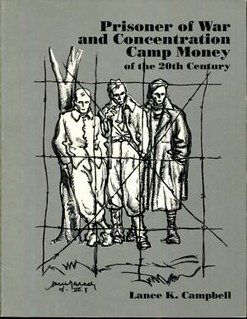 "I was wondering if anyone would be able to assist me. I am trying to find a copy of the Campbell Catalog on POW banknotes to purchase.
If not, would anyone be able to provide me with the actual title of the catalog and the author's full name so that I may be able to search for it?"
"I was wondering if anyone would be able to assist me. I am trying to find a copy of the Campbell Catalog on POW banknotes to purchase.
If not, would anyone be able to provide me with the actual title of the catalog and the author's full name so that I may be able to search for it?"
I was unsure about the name of the book myself. I checked with Ray Czahor who doesn't have it in stock, but was able to give us this identification: Lance Campbell, Prisoner of War and Concentration Camp Money of the Twentieth Century, Second Edition, 1993. It was published by BNR Press. I found an image of the 1st edition online. Can anyone help Mark find a copy? Thanks. -Editor
THE BOOK BAZARRE
QUERY: LEGENDARY COINS
New member Ed Kelliher writes:
"I'm just learning about the NBS, and have just sent out my check for a 3-year print-and-digital membership.
In the meantime, I could really use your help: Throughout my search, you appear to be the authorized reference source closest to that which I'm investigating. Specifically, I seek articles and/or artifacts (books, magazines, etc.) that focus on what makes a coin special, and how it got that way, including the history leading up to the coin's notoriety.
So, for example, I know there are accounts out there that talk to the beautiful and (in)famous 1916 Standing Liberty quarter. Well, in similar vein, there MUST be similar accounts for the why and how behind the 3-legged buffalo(es), the allure of overdates and multiple mintmarks, the driver(s) behind minting ultra-high relief specimens, the fuzzy universe of double dies, the history behind the "heavy" 1852-O quarter, etc...I could go on and on.
Is there, like, a certain series of books or articles that I can buy ?
A Sincere Thanks for any/all information you can provide !"
Welcome to NBS!
Almost any book by Q. David Bowers would fit the bill at least in part. Adventures With Rare Coins and the sequel More Adventures With Rare Coins are good places to start. Some other good general books in my library include Twisted Tails: Sifted Fact, Fantasy and Fiction From U.S. Coin History by Robert Van Ryzin and Facts & Fictions About Coins by Leon Lindheim. A newer one covering some interesting oddball topics is Keep the Change: A Collector's Tales of Lucky Pennies, Counterfeit C-Notes, and Curious Currency by Harley J. Spiller.
I can also highly recommend Roger Burdette's well-researched three volume work, Renaissance of American Coinage covering the 1905-1921 period. A great coffee-table book on errors is Mike Byers' World's Greatest Mint Errors. And Whitman Publications has a whole series of "100 Greatest" books including titles on U.S. coins and U.S. error coins. Most of these are out of print but available thru numismatic booksellers and Internet sellers.
I reached out to NBS Board member Joel Orosz who provided a number of great additions. Thanks! What else would readers recommend? -Editor
I think you have gotten Mr. Kelliher off to a great start. I have a few ideas to add:
In addition to QDB's two Adventures with Rare Coins books, he also wrote two Coins and Collectors volumes that also talk a lot about "special" coins, and what makes them the subject of so much longing and romance.
Of course, one must not forget the intriguing story of the enigmatic 1792 half dismes, as told by Pete Smith, Joel J. Orosz and Leonard Augsburger in their award-winning 1792: Birth of a Nation's Coinage. Not only are the authors insightful and scholarly, they are all ruggedly handsome, too!
Eric P. Newman's The Secret of the Good Samaritan Shilling is a must-read, as is Newman's and Ken Bressett's The Fantastic 1804 Dollar.
For the 1913 Liberty Head nickels, there is Paul Montgomery, Mark Borckardt and Ray Knight, Million Dollar Nickels.
Kevin Flynn's The 1894-S Dime: A Mystery Unraveled, is a good read, as is Jim Neiswinter's The Aristocrat: The Story of the 1793 Sheldon 15.
QDB's The 1822 Gold Half Eagle: The Story of a Rarity, covers this legendary coin well. So does Alison Frankel for the 1933 double eagle in her Double Eagle.
Martin Logies covers The Flowing Hair Silver Dollars of 1794, and Dean Albanese rather breathlessly hypes the 1804 plain-4 proof eagle in King of Eagles: The Most Remarkable Coin Ever Produced by the U.S. Mint.
Finally, an oldie but goodie, Don Taxay's Counterfeit, Mis-Struck, and Unofficial U. S. Coins, has a clunky title, but absolutely fascinating contents. It covers coins as familiar as 1914-D Lincolns and 1937-D "Three-Legged" Buffalo nickels, to more esoteric delicacies, as the "Novum Belgium" piece, or the "1805" silver dollar.
Oddly, there are a couple of prized pieces for which I cannot think of a single comprehensive book written about them, namely the Brasher Doubloon and the 1848 "Cal." quarter eagle.
Of course, a thorough search of the Newman Numismatic Portal could turn up articles by the dozen on these topics. But these books should be enough to keep Mr. Kelliher occupied for a while.
Finally, I'd encourage Mr. Kelliher to write an article on his findings for The Asylum. It is amazing how often important details from key references are overlooked, even when that reference has been in print for a long time.
HEPTAGONAL HALF DOLLAR DESIGN SUGGESTIONS
Wayne Pearson submitted these thoughts on potential news designs for the U.S. half dollar. Thanks. -Editor
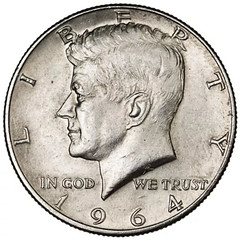 When the Eisenhower dollar was reduced in size, we received a new design in Susan B. Anthony.
When the Eisenhower dollar was reduced in size, we received a new design in Susan B. Anthony.
When the dollar coin became the ‘Golden dollar', again we received a new design.
I recently suggested that in order to get the half dollar coin used, in vending machines, we could reduce it in size and change the shape to a heptagon like they have in the United Kingdom.
Since then, I've been thinking, with a smaller version with a different shape, would a new design of a different person also be merited instead of a different version of John F. Kennedy?
Many people could be used. I've worked up a few ideas. Would we keep it in the family with Robert F. Kennedy? Would we use a different political party with Theodore Roosevelt? Would we use a woman, like Alice Paul?
Or would we take the coin in a different direction, away from politics, and use someone like Johnny Carson, a favorite of mine.
Or yet another?
I'm sure all of you have a thought on someone you would like to see on a coin.
Our coins really need something to excite collectors. The new Washington on the quarter after 90 years of the same design is a welcome relief.
Many of us are old enough to remember late night TV host Johnny Carson. I wouldn't vote to honor him with a coin, but it's never a bad idea to consider new designs for coins past their expiration date. I like both the Alice Paul and Teddy Roosevelt ideas. What do readers think? -Editor
To read the earlier E-Sylum article, see:
KENNEDY HALF DOLLAR DESIGN PROPOSAL
(https://www.coinbooks.org/v25/esylum_v25n15a19.html)
References:
Etats Unis. John et Robert Kennedy. Médaille or. 26 mm
(https://www.poinsignon-numismatique.de/munzen_r5/gold-medaillen_c7/auslander_p75/etats-unis-john-et-robert-kennedy-medaille-or-26-mm_article_63039.html)
CCAC Reviews William McKinley and Thoedore Roosevelt Presidential Dollar Designs
(http://news.coinupdate.com/ccac-reviews-william-mckinley-and-thoedore-roosevelt-presidential-dollar-designs/)
The Serene Strategist
(https://thepenngazette.com/the-serene-strategist/)
Heeere's Johnny Carson, an ‘American Masters' film
(https://www.sandiegouniontribune.com/sdut-heeeres-johnny-carson-an-american-masters-film-2012may11-story.html)
AUGMENTED REALITY BANKNOTE DEBUTS
Bob Bednar has been working with banknote printer Royal Joh Enschede on a new banknote-like collectible product. Here's the press release for the latest example. -Editor
Royal Joh Enschede, a 300 year old printer of banknotes, released their first "Banknote with Augmented Reality" a few weeks ago. The Limited edition banknote contains full banknote security and includes Augmented Reality for an interactive experience for the collector. Featuring popular Dutch singing duo Nick & Simon, the proceeds of the sale raise awareness & funds for Epilepsy in the Netherlands. Nick & Simon's portraits were designed by American banknote artist Tom Stebbins. After loading the app on your phone, Nick & Simon seem to "Jump out" of the banknote and perform & entertain.
At this time the note is only available in Europe but RJE hopes to connect with coin dealers willing to purchase & sell the notes & folders here in the US.
The banknotes were designed to help raise awareness & funds for Epilepsy in the Netherlands. Already over 250,000 Euro has been raised. It's our hope that Banknotes with augmented reality could become an excellent fundraising tool for other charities. RJE is working on several projects which will be Limited Edition collectors notes.
Here is the short video of the making of this historic banknote. Please see www.MyEventNote.com
To read the earlier article, see:
CUSTOM AUGMENTED REALITY BANKNOTES OFFERED
(https://www.coinbooks.org/v23/esylum_v23n44a16.html)
VOCABULARY TERMS: INSCRIBE, INSCRIBING
Here's another entry from Dick Johnson's Encyclopedia of Coin and Medal Terminology. -Editor
Inscribe, Inscribing.
To cut a line into hard material, as metal, to form a letter or design; flat engraving. The inscriber does not create relief but does engraving on a flat surface, often the reserve on an existing piece, as a medal requiring customized lettering for a particular recipient. The word inscribe and its process is far overshadowed by the word engrave in current usage. The purist would say a person would inscribe a medal, but engrave a die. The engraver cuts away metal to form modulated relief, the inscriber does not change the relief but merely performs an engraving operation on an existing surface. The tools used for both functions are the same, even the scriber – a sharp pointed hand tool to score or scribe a line on a metal surface – or the cutting point on an engraving machine produces only a fine line (particularly in drag engraving); also in acid etching lines are inscribed on the surface where a sharp pointed scriber removes the wax to acid etch a fine line. In the future we shall undoubtedly find the word engrave
to include all the meaning of inscribe, the two words will probably never be differentiated, as, perhaps, they should be. See engraving, acid etching.
The area to be inscribed on a medal has special names. If the area is completely open in the design for that side it is called a RESERVE. If it is within a panel it is called a CARTOUCHE which is most often worked into the design. In at least one instance a medal designer, Frederick Ziegler, added a wide rim to the reverse of the Diamond Match Company Service Medal, where the recipient's name could be inscribed.
For the characteristics of various metals for inscribing see the chart in the entry on engraving. Some medals are WORK HARDENED from striking thus may be slightly harder for inscribing than that stated in the chart.
To read the complete entry on the Newman Numismatic Portal, see:
Inscribe, Inscribing
(https://nnp.wustl.edu/library/dictionarydetail/516149)
ROBERT BASHLOW, PART ONE
American Numismatic Biographies author Pete Smith submitted this article on the enigmatic Robert Bashlow, known in numismatics for, among other things, creating satirical medals and restrikes of the Confederate cent. Thanks. This is a multipart series, and this first installment examines some unsavory family history likely unknown to Bashlow's friends and acquaintances in the hobby. -Editor
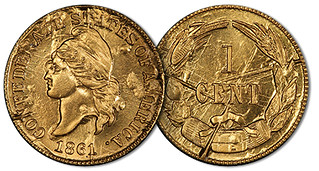 I have written more than 3500 biographical sketches in the past 33 years. Some of them are forgotten an hour after I finish and move on to something else. Some stick with me and curiosity brings me back to them for additional information. Such is the case with Robert Bashlow, mentioned last week in The E-Sylum.
I have written more than 3500 biographical sketches in the past 33 years. Some of them are forgotten an hour after I finish and move on to something else. Some stick with me and curiosity brings me back to them for additional information. Such is the case with Robert Bashlow, mentioned last week in The E-Sylum.
David T. Alexander had an excellent article about Bashlow in CoinWeek for September 6, 2016. Alexander reported, Numismatists who knew Bashlow in his heyday, such as Q. David Bowers, recall that his parents were respectable and well-off, manufacturers of precision anti-dust laboratory equipment.
I have great respect for David T. Alexander and Q. David Bowers. I consider both of them as friends and fellow members of the Rittenhouse Society. However, in the case of Robert Bashlow's parents, I think they missed something.
Robert Bashlow was the son of Archibald Archie
Bashlow and Rebecca Kush Bashlow. Archie was born in Providence, Rhode Island, on November 27, 1907. When I looked for him in the 1930 Census, I found something I had not previously seen in a Census listing. In 1930 he was a prisoner at the Eastern State Penitentiary in Philadelphia.
Archie was the youngest of five brothers. In 1926, he and his older brother George opened Store of Gifts
in Hackensack, New Jersey. Neither of them had experience managing a retail store but the store was described as successful.
 In 1928 Archie and his brother Charles were charged with white slavery and violation of the Mann Act. It was alleged that they brought 19-year-old Ethel Bowen from New York to Easton, Pennsylvania, with promises of good clothes, jewelry and a job in retail. She was taken to a house of ill-repute and offered to various disorderly house managers before she was sold for $1000. She escaped and reported to the authorities.
In 1928 Archie and his brother Charles were charged with white slavery and violation of the Mann Act. It was alleged that they brought 19-year-old Ethel Bowen from New York to Easton, Pennsylvania, with promises of good clothes, jewelry and a job in retail. She was taken to a house of ill-repute and offered to various disorderly house managers before she was sold for $1000. She escaped and reported to the authorities.
There were others involved. One newspaper article stated,
"Three men were immediately arrested, two of whom are said to be leaders of a gang of White Slavers running New York and New Jersey girls to gangs in other states. Another article said, A number of underworld characters were present in the court room, where police officers searched them for weapons."
Today such crimes fall under the larger umbrella of "human trafficking". The term "White slave" is typically defined as "a woman who is sold or forced into prostitution" or "a White person held in slavery." -Editor
While in jail awaiting trial, the Bashlow brothers and two others conspired to overpower guards, take their guns and keys and walk out of jail. A search of their cells turned up sections of copper pipe and a blackjack. The break was thwarted after another inmate ratted on the conspirators.
Archie and Charles were convicted and received sentences of four to eight years in the penitentiary. It turned out that the girl had provided a false identity. She was actually 16-year-old Sabine Berger of Passaic, New Jersey. I would not use the word respectable
to describe the brother's business.
By 1933 the brothers were out of prison and opened Bashlow Brothers Coal Company in Hackensack. In 1939, George Bashlow, as weighmaster, and Archie Bashlow, as delivery driver, were charged with shorting the Teaneck High School on a load of coal. As Archie was driving the truck to a second weigh station to confirm the weight, he accidentally raised the truck box and dumped part of the load on the roadway. George was fined $100 and Archie was fined $50. In the 1940 census, Archie was listed as a coal truck driver.
Archie married Rebecca Kurk on December 23. 1935. She was a Brooklyn school teacher and graduate of New York State Normal School and Cornell University. Robert was their only child.
In 1964, Archie applied for a patent on a dust-proof cabinet. He went into business with Liverpool Industries in Brooklyn. In the December 1987 issue of The Numismatist, Q. David Bowers recalled Robert Bashlow. He reported that he bought several hundred shares of stock in Liverpool Industries from Robert at $2.50 per share and the price soon dropped to 25 cents a share.
A 1977 newspaper article featured senior citizens attending classes at Kent State University. Among those profiled were Archie and Rebecca Bashlow. Archie was described as former vice president of Liverpool Industries in Brooklyn. Archie may have achieved the appearance of respectability late in life.
Rebecca died on May 30. 1979, in Wadsworth, Ohio, a few months before her son Robert. Archie Bashlow died on February 14, 1989, in Miami. Or did he? There is a curious record that he was living in Wadsworth, Ohio, in 2001. Another website indicates he is living in Wadsworth, Ohio, at age 114. Biographers should learn to be skeptical of some records.
What values did respectable Archie pass on to his son, Robert? How far did the apple fall from the tree?
In the next installment, I will discuss the life of Robert in greater detail.
The newspaper clipping is courtesy Julia Casey. From the New York Daily News, August 31, 1928. Other citations include: Jersey Journal, Jersey City, NJ, August 30, 1928, The Morning Call of Patterson, NJ, September 22, 1928 and The Alliance Review, August 19, 1997. -Editor
To read dictionary definitions, see:
https://www.collinsdictionary.com/us/dictionary/english/white-slave
https://www.merriam-webster.com/dictionary/white%20slavery
https://en.wikipedia.org/wiki/White_slavery
To read the complete CoinWeek article, see:
Robert Bashlow
(https://coinweek.com/us-coins/robert-bashlow/)
HARVEY STACK'S NUMISMATIC FAMILY, PART 120
Stack's Bowers has a backlog of the late Harvey Stack's numismatic memoir articles and will continue publishing them. In this one Harvey discusses his role in the birth of the Statehood Quarters. -Editor
As I ended last time, I had been invited to speak at a hearing of the U.S. banking committee along with others in the hobby, to talk about the loss of interest in the U.S. Mint's modern commemorative programs. Congressman Jimmy Hayes, a collector and friend to me, had come to the committee specifically to introduce me to his colleagues. I thanked Jimmy for the introduction and started to relate my experiences with the current Mint products. Since all the issues from 1982 to 1995 were offered initially by the Mint with high profits above any face value or precious metal value, once sold to the public a very weak secondary market developed. This went contrary to the Mint's promotions that called them "An Investment in the Future." I then told the story (previously related here) of a lovely grandmother who came into our shop to sell these items she had bought as an investment for her grandchildren and her disappointment at how their value had dropped. I told many clients about this, and all said they experienced the same when offering their new issues for sale.
Congressman Castle stopped me and posed the following question: "What would you suggest, Mr. Stack, to remedy this situation?"
I carefully responded by telling of how when I was younger I could find a coin or two in change or on the street that was interesting to me as a collector – something different. Like many other youngsters, I assembled a small group, traded duplicates with my friends or family members and in that way built a small collection that cost me just face value. From rolls and handfuls of nickels and pennies I was able to fill out my holdings, and it was fun for very little cost. This was similar to how others started in the hobby.
Congressman Castle stopped me again: "What would you do to get people to again collect?"
I responded: "I think the Mint should issue a series of coins that would be found in daily change but would be different from each other. This would get people to look at their coins, recognize when there is an item that looks different or interesting, set it aside and start to build an initial collection, all at face value!"
I thought of an idea that might do the trick. I thought the Mint could start a new series of quarters that would be commemoratives in that they would feature an event in history. But, they would also be circulating coins that would be used in commerce. These quarters would honor the formation the confederation of states that became the United States and could start with the first state to join the Union. The other states could follow, in the order they joined.
Congressman Castle again spoke: "Mr. Stack, do you know that Delaware, the state I represent today, was the first state to sign up?"
I replied. "Sir, if I didn't know before I surely know now!" I suggested that perhaps five different quarters could be issued each year, with one side featuring a historical event or site representing the state or an important landmark or product from that state. These could be issued in large amounts to be used as everyday change and be collectable at face value. I continued: "Sir, this series of 50 new designs could be known as the Statehood Commemorative Issue Quarters." This idea appealed to the committee and Congressman Castle said that they would look into it further. That was how the Statehood Quarter program got started.
After I spoke and received warm compliments from the other Congressmen present, Director of the Mint Philip Diehl spoke, agreeing with the ideas I set forth. However, as it was a government body, he exhibited his political training, saying that he would look into the program, and report back to the committee for further authorization. The meeting was then closed, and most left with warm smiles on their faces. It was an important day for me, and I felt like I had been able to do something to help the hobby.
To read the complete article, see:
Growing up in a Numismatic Family: Part 120
(https://www.stacksbowers.com/News/Pages/Blogs.aspx?ArticleID=growing-up-in-a-numismatic-family-part-120)
To read the earlier E-Sylum article, see:
HARVEY STACK'S NUMISMATIC FAMILY, PART 119
(https://www.coinbooks.org/v25/esylum_v25n16a12.html)
UPCOMING NUMISMATIC EVENTS: MAY 1, 2022
Here are announcements of some upcoming numismatic events around the world.
- The International Congress of Medieval Studies item is from the American Numismatic Society,
- the item from the Catalan Society of Numismatic Studies is submitted by Robert Hoge,
- George Cuhaj submitted the information on the International Token Web Conference,
- and the May World of Coins meeting.
International Congress of Medieval Studies
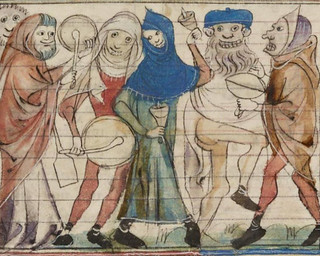 The ANS is sponsoring a session on medieval numismatics at the virtual International Congress of Medieval Studies on Monday, May 9. The session is entitled Coinage, Money, and the State in Medieval Europe. Mark Salton Associate Curator of Medieval, Renaissance and Early European Numismatics David Yoon will present the paper State Action, Improvisation, and the Making of Visigothic Coinage. ANS Members Ruth Pliego and Jane Sancinito will also present during this session.
The ANS is sponsoring a session on medieval numismatics at the virtual International Congress of Medieval Studies on Monday, May 9. The session is entitled Coinage, Money, and the State in Medieval Europe. Mark Salton Associate Curator of Medieval, Renaissance and Early European Numismatics David Yoon will present the paper State Action, Improvisation, and the Making of Visigothic Coinage. ANS Members Ruth Pliego and Jane Sancinito will also present during this session.
For more information, see:
International Congress on Medieval Studies
(https://wmich.edu/medievalcongress)
The Catalan Society of Numismatic Studies
La Societat Catalana d'Estudis Numismàtics (SCEN - The Catalan Society of Numismatic Studies), an off-shoot of the Institut d'Estudis Catalans (the IEC - the Institut of Catalan Studies), is convoking an event in celebration of the appearance of its two newest publications:Acta Numismàtica, 52: Homenatge al Dr. Miquel de Crusafont i Sabater (Numismatic Acts, 52: Tribute to Dr. Miquel de Crusafont i Sabater)
and
Diàlegs de monedes, medalles i anàlegs de Tarragona, by Jaume Benages i Olivé. (Dialogues of coins, medals and analogues of Tarragona, by Jaume Benages i Olivé.)
The first will be presented by Rossend Casanova i Mandri, President of the SCEN, and the second, by Dr. de Crusafont himself. The event is to take place May 17, at 7:00 p.m. in the Sala Prat de la Riba of the Institut d'Estudis Catalans, C/ Carme 47, 08001, in Barcelona, Spain.
For more information, see:
https://blogs.iec.cat/scen/
International Token Web Conference
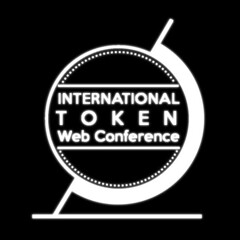 The International Token Web Conference is back on 07 and 08 May 2022.
The International Token Web Conference is back on 07 and 08 May 2022.
As before, the worldwide non-commercial online event will be free and present renowned token experts from all over the world and a public from all the continents.
The event will also hold Thematic Rooms spread over the weekend. These will be Zoom meetings with smaller groups that will talk informally about the theme of the room, while at the same time bringing together people with the same interests.
Registration is free but required so you can receive the links for the events and Zoom sessions, and the free eBook of proceedings afterwards.
Register and find more information at the official event website: http://tokenconference.numismatas.com.
For more information, see:
https://www.facebook.com/TokenWebConference
World of Coins May Event
For more information, see:
http://www.worldofcoins.eu/
2022 ANA MONEY TALKS AND SUNDMAN LECTURES
E-Sylum readers are experts on every numismatic topic under the sun. Please consider presenting at the upcoming 2022 American Numismatic Association World's Fair of Money convention outside of Chicago. Here are excerpts from the press release. -Editor
Money Talks Overview:
Share your expertise, ideas and research with fellow hobbyists during a 30- to 45-minute Money Talks presentation. Previous presentations have included such topics as Siege Notes: The Currency of War,
Strategies to Dispose of Your Collection and Curious Currency of the World.
Submission Guidelines:
Those interested in giving a Money Talks presentation should submit proposals and a brief bio online at money.org/numismatic-events/money-talks or email sgelberd@money.org. Presentations should be accompanied by digital images.
Proposals are due no later than Saturday, April 30.
Free and open to all attendees of the World's Fair of Money, Money Talks will take place Thursday and Friday, August 18 and 19 at the Donald E. Stephens Convention Center in the Chicago suburb of Rosemont.
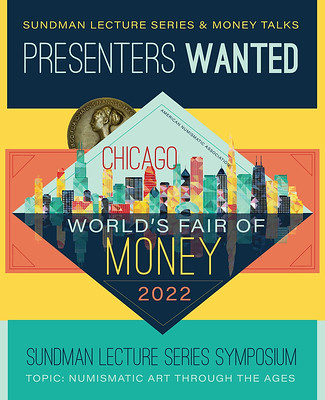 Sundman Lecture Series Symposium
Sundman Lecture Series Symposium
TOPIC: Numismatic Art Throught the Ages
Symposium Overview:
From the earliest times engravers created the first dies, molds or printing plates, certain examples have been recognized for their outstanding artistry and beauty. From the ancient coins of the "Naxos Master" to Augustus Saint-Gauden's Liberty design for the 1907 $20 or Will Hicok Low's design for the front of the 1896 $5 silver certificate or the Renaissance medals of Pisanello, this year's Sundman Lecture submissions should be based on masterpieces of numismatics. Papers that emphasize new research and scholarship will be prioritized.
Submission Guidelines:
If you wish to be a speaker at the symposium, please submit a summary of your lecture, not to exceed 500 words. Each summary should contain an introduction, a brief discussion of the subject, and sources and research method. Electronic submission are preferred, but not required.
The deadline for submission is June 3. Submissions should be sent to Douglas Mudd at mudd@money.org.
For more information, see:
Money Talks Numismatic Lectures
(https://www.money.org/numismatic-events/money-talks)
Sundman Lecture Series Symposium
(https://www.money.org/presenters-wanted)
TOP ANA AWARD NAMED FOR CHESTER L. KRAUSE
This press release announces the new name for the ANA's top service award. Great choice! -Editor
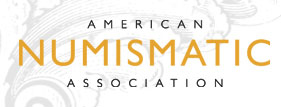 The first-ever Chester L. Krause Memorial Distinguished Service Award will be presented at the American Numismatic Association's 2022 World's Fair of Money® in Chicago (August 16-20). The ANA Board of Governors made the decision to rename the accolade at its April 12 meeting to honor the memory and contributions of the renowned numismatic publisher.
The first-ever Chester L. Krause Memorial Distinguished Service Award will be presented at the American Numismatic Association's 2022 World's Fair of Money® in Chicago (August 16-20). The ANA Board of Governors made the decision to rename the accolade at its April 12 meeting to honor the memory and contributions of the renowned numismatic publisher.
The founder of Krause Publications, Chester L. Krause (1922-2016) grew from humble beginnings in rural Wisconsin to become one of the Association's most philanthropic members. His namesake company's first periodical, Numismatic News, released its first issue in October 1952. Krause funded this endeavor with $1,342 of his own money. He joined the ANA the following year.
As his business grew to include reference books and additional magazines, so did his generosity for the hobby and the ANA. In 1974 he inaugurated the Numismatic Ambassador Award, which recognized individuals who have dedicated themselves to sharing the joys of numismatics with others. Ten recipients were named in the first year, and this time-honored award is bestowed on deserving hobbyists to this day. Along with Clifford Mishler and an anonymous party, Krause supported and funded the naming of the ANA's Money Museum in honor of former Executive Director Edward C. Rochette. Krause's likeness appears in the museum's plaza as a member of the Numismatic Hall of Fame, an honor he received in 1990. The publishing powerhouse received the Burnett Anderson Memorial Award for Excellence in Numismatic Writing, jointly bestowed by the ANA, the American Numismatic Society, and the Numismatic Literary Guild, in 2009. Krause was posthumously recognized with the ANA's Philanthropy Award in 2019.
Krause has been honored with almost every ANA service award, receiving the Medal of Merit (1967), the Farran Zerbe Memorial Award for Distinguished Service (1977), the Glenn Smedley Memorial Award (1991), the Lifetime Achievement Award (1994), the Numismatist of the Year (1999), and the Exemplary Service Award (2005).
The Distinguished Service Award, established over 70 years ago by Louis S. Werner to memorialize former ANA President Farran Zerbe, was originally an engraved plaque presented "for Distinguished Service and for advancement of the Science of Numismatics rendered to the American Numismatic Association." Over time, the award expanded to include a gold medal.
In 2021 the ANA Board of Governors voted to vacate the naming of the award to create an opportunity to name it after a contemporary figure in numismatics and to secure funding to produce the medal. When the decision was reported, historical allegations against Zerbe were also published, which some believed was the board's indictment of Zerbe and the reason for the removal of his name. The Board of Governors clarified that this was not the case and affirms Farran Zerbe's significance in the Association's history. (Most notably, Zerbe, alongside George F. Heath, was inducted into the Numismatic Hall of Fame in its inaugural class in 1969.)
Funding for the naming rights for the Chester L. Krause Memorial Distinguished Service Award comes from a groundswell of support from numismatic colleagues and longtime friends and will sustain the award for years to come.
For more information on ANA service awards, see:
ANA Service Awards
(https://www.money.org/american-numismatic-association-awards)
To read the earlier E-Sylum articles, see:
ZERBE NAME REMOVED FROM ANA TOP AWARD
(https://www.coinbooks.org/v24/esylum_v24n39a17.html)
CHESTER L. KRAUSE, 1923-2016
(https://www.coinbooks.org/esylum_v19n26a02.html)
TOP PNG AWARD NAMED FOR HARVEY G. STACK
The Professional Numismatists Guild (PNG) has named its top award for our longtime contributor Harvey Stack. Here's the press release. -Editor
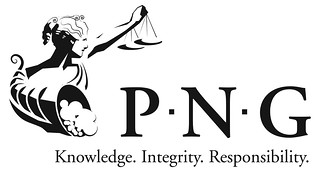 The Professional Numismatists Guild has named its annual Lifetime Achievement Award in honor of former PNG President Harvey G. Stack of New York City who passed away earlier this year at the age of 93. The 2022 recipient of the newly-named award is veteran California dealer Jack H. Beymer.
The Professional Numismatists Guild has named its annual Lifetime Achievement Award in honor of former PNG President Harvey G. Stack of New York City who passed away earlier this year at the age of 93. The 2022 recipient of the newly-named award is veteran California dealer Jack H. Beymer.
Harvey Stack was an icon of the numismatic world, a respected dealer who emphasized the educational importance as well as enjoyment of collecting. He joined PNG in 1978 and served as our President from 1989 to 1991. The PNG Board voted unanimously to recognize his outstanding achievements by adding his name to one of our most important annual awards,
explained PNG Executive Director Robert Brueggeman.
The Harvey G. Stack Lifetime Achievement Award is presented by PNG to a numismatist for his or her extraordinary devotion to numismatics and who, over their lifetime, significantly contributed to the hobby or profession. This year's recipient, Jack Beymer, has operated Big Oak Plaza Coins in Santa Rosa, California since 1971 and is known nationwide for his passion for the hobby and profession. He joined PNG in 1975.
That award and other 2022 PNG honors were announced at the organization's awards reception held in conjunction with PNG Day, April 27, at the Central States Numismatic Society convention in the Chicago suburb of Schaumburg, Illinois. The Robert Friedberg Award, presented to an author in recognition for an outstanding book or other literature, was given to Rusty Goe of Southgate Coins in Reno, Nevada, author of The Confident Carson City Coin Collector. This acclaimed three-volume, 2,500-page reference work is about the historic Nevada branch mint and coins struck there from 1870 to 1893.
The Significant Contribution Award was presented to James A. Simek of NumisGraphic Enterprises in Westchester, Illinois for his exceptional, beneficial efforts over the years on behalf of PNG as well as the profession and the hobby. Simek joined PNG in 1980, has been a member of the PNG Board since 2009, and has served as PNG Secretary since 2015.
The Sol Kaplan Award that recognizes efforts and contributions to combat crimes against the numismatic community was presented to Jack D. Young of Dayton, Ohio for his help to fight fraud and thievery. Young has extensively assisted researchers, third-party grading services, online shopping platforms, and law enforcement in the identification of deceptive fakes offered in the marketplace and is the founder of the Facebook counterfeit watch group, The Dark Side.
In a related honor, the Anti-Counterfeiting Educational Foundation (www.ACEFonline.org) presented its annual Alan Kreuzer Memorial Award to Chris Hersey, Senior Special Agent for the United States Department of the Treasury Office of Inspector General. ACEF Director of Anti-Counterfeiting Doug Davis said that Agent Hersey has been instrumental in assisting ACEF in coordinating cases with the different levels of federal agencies responsible for the investigation of counterfeit coins and precious metals. He also assisted ACEF in conducting anti-counterfeiting and numismatic crimes educational seminars for law enforcement in California and Texas.
The PNG also recognized three dealers for 50 years of membership by presenting them with complimentary Lifetime Memberships: Harlan J. Berk of Harlan J. Berk, Ltd., Chicago, Illinois; Lyn F. Knight of Lyn F. Knight, Overland Park, Kansas; and Julian M. Leidman of Bonanza Coins in Silver Spring, Maryland.
Berk, who served as PNG President from 2001 to 2003, joined PNG 51 years ago in 1971, however, last year's awards ceremony was not held because of the pandemic, so the formal recognition was delayed until this year's event.
The Professional Numismatists Guild is a nonprofit trade association composed of the country's top rare coin and paper money dealers who must adhere to a strict Code of Ethics in the buying and selling of numismatic merchandise. The organization also has an Accredited Precious Metals Dealer program (www.APMDdealers.org).
Congratulations to all of this year's worthy recipients. -Editor
For more information on PNG, see:
https://pngdealers.org/
SEDWICK TREASURE AUCTION 31 ANNOUNCED
Here's the announcement for this month's Daniel Frank Sedwick sale. -Editor
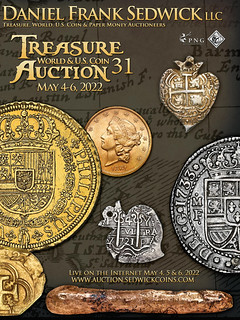 Welcome to our 31st Treasure Auction, a sale filled with many historical numismatic rarities from many eras all across the world!
Welcome to our 31st Treasure Auction, a sale filled with many historical numismatic rarities from many eras all across the world!
We start off Session I with Gold Cobs, featuring a selection of excellent certified Mint State gold escudos from the 1715 Fleet including a Lima, Peru 8 escudos dated 1713 M (lot 44), two different types of the Mexico 8 escudos 1714 J GRAT variety: one with 1714 on the reverse and the other with 1714/GRAT on the obverse (lots 33 and 34), a Lima, Peru 8 escudos 1709 M with HISPANIA legend variety from the Pullin Collection, and the finest known Bogotá, Colombia 2 escudos dated 1712 (lot 60). Among the non-Fleet shipwreck gold cobs, we have the rare Lima, Peru 8 escudos dated 1715 M from the Loosdrecht (1719) along with a Lima, Peru 4 escudos dated 1750 R with the cross side struck from an 8 escudos die recovered from the Luz (1752).
Our Shipwreck Ingots section contains several notable pieces including an impressive early New World tumbaga
gold bar weighing 1,222 grams from the Tumbaga Wreck
(ca. 1528) (lot 65), a beautiful gold disk weighing 216.4 grams from the 1715 Fleet (lot 69), and two cut segments of gold finger
bars from the Atocha (1622) (lots 67 and 68). These gold bars, along with the massive silver bars and numerous coins in this sale, are sure to attract significant interest given this year being the 400th anniversary of the sinking of the Atocha and Santa Margarita on Sept. 6th, 1622 off the Florida Keys. Most notable among the section Shipwreck Coins (1500s-1650s) is the 1622-dated Seville, Spain cob 2 escudos from the Santa Margarita, which is a cover coin in Duncan Mathewson's iconic work, Treasure of the Atocha (1986) (lot 169) along with a partially dated and graded Seville, Spain cob 2 escudos from the Atocha, plus a choice, fully dated Bogotá, Colombia cob 4 reales dated 1622 A, pedigreed to both the Atocha Research Collection and the Pat Johnson Collection (lot 164).
Other important lot offered under Shipwreck coins (1660s-1740s) include a Potosí, Bolivia cob 8 reales dated 1714 Y from the pirate ship Whydah (1717) (lot 271), a large variety of reales from the ever-popular 1715 Fleet, finally under Shipwreck Coins (1750s-1900s) there is a US $20 double eagle dated 1861 from the SS Pewabic (1865) (lot 345).
As we start Session II with Mexico Silver Cobs, we're pleased to host our first offering of selections from the Clyde Hubbard Collection of Charles-Joanna Coinage as lots 360 to 494, including the finest-ever offering of Late Series
1/2R. This collection, assembled by the late expert numismatist over 70-plus years, represents his life's work in acquiring New World rarities such as the finest graded Early Series
3 reales of assayer R (lot 366), the rare Late Series
4 reales of assayer S (lot 428), and a high grade Early Series
2 reales with assayer R (Latin variety) (lot 368). In Lima Silver Cobs we have a rare and choice Philip II 4 reales of assayer X (lot 548) in addition to other Lima cob rarities. Potosí Silver Cobs contains a large selection of rare Royals, from the finest NGC-graded 8 reales Royal dated 1729 M to the elusive 8 reales Royal dated 1712 Y. Pay particular attention to the two unique Potosi Hearts
of the sale: a 1720 Y 4 reales Heart from the Pat Johnson Collection and the 1721 Y 4 reales Heart plated in the Practical Book of Cobs.
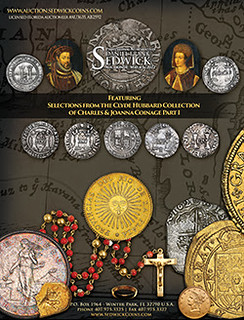 The second day of our auction starts with World Coins, containing Latin American gold rarities such as the finest La Rioja, Argentina 8 escudos dated 1845 RB (lot 679), the very rare Argentina 1834 P 8 escudos (lot 668), and the exquisite and finest prooflike Santiago, Chile 10 pesos dated 1863/2 (lot 720). Several impressive Spanish rarities in the sale include the very rare Seville-minted gold 4 escudos of Charles II dated 1700 M (lot 1107), the difficult Segovia-minted gold 8 escudos of Philip V dated 1721/19 F (lot 1109), and the Mint State Madrid-minted gold 320 reales de vellon of Ferdinand VII dated 1822 SR (lot 1130).
The second day of our auction starts with World Coins, containing Latin American gold rarities such as the finest La Rioja, Argentina 8 escudos dated 1845 RB (lot 679), the very rare Argentina 1834 P 8 escudos (lot 668), and the exquisite and finest prooflike Santiago, Chile 10 pesos dated 1863/2 (lot 720). Several impressive Spanish rarities in the sale include the very rare Seville-minted gold 4 escudos of Charles II dated 1700 M (lot 1107), the difficult Segovia-minted gold 8 escudos of Philip V dated 1721/19 F (lot 1109), and the Mint State Madrid-minted gold 320 reales de vellon of Ferdinand VII dated 1822 SR (lot 1130).
In Session IV, the Medals and Decorations offering contains several important pieces such as the Philippines gilt-silver medal of Charles III from 1782 engraved by Gerónimo Antonio Gil (lot 1218), the Peru silver-plated bronze essai medal dated 1824 commemorating the Liberation of Ayacucho (lot 1216), and the Guatemala silver proclamation medal of Ferdinand VII from 1808 (lot 1207). We're excited to offer the second part of Admiral Vernon medals from the John Adams Collection here as well. Following that, in U.S. Coins, we have a strong assortment of better and high grade Morgan dollars in the Blakewood Collection as well as other rarities like the 1851 San Francisco Standard Mint nickel alloy pattern $5 (lot 1267) and the Dahlonega gold $5 half eagle 1841-D with very rare tall mintmark variety (lot 1227). You'll notice that there is no US and World Paper Money following US coins; we are hosting our first ever exclusive US and World Paper Money Auction on July 1st of this year. Interested consignors should contact us by May 31st to take advantage of our new auction.
Several important and beautifully designed rarities are present in Ancient Coins like the Aegina silver stater from 350-338 BC with a high relief land tortoise design (lot 1272), the Carthage gold stater from 320-310 BC formerly in the British Museum Collection (lot 1289), and the Byzantine gold solidus of Justinian II with a well-defined depiction of Christ (lot 1297). Coin Jewelry is decorated with lots of shipwreck coins in mounts ready for wearing, including a Lima, Peru gold cob 8 escudos dated 1711 M from the 1715 Fleet (lot 1304) and a Grade 1 Potosi, Bolivia cob 4 reales of assayer Q from the Atocha (1622) (lot 1326).
Our Shipwreck Artifacts hosts several amazing and rare pieces recovered from the 1715 Fleet: an intact gold and red-coral rosary (lot 1364), a 56 long gold olive blossom chain (lot 1365), and a historically significant 20-karat gold ring engraved inside with the Prayer of Saint Zacharias (lot 1366). Within Non-Wreck Artifacts, there's a veritable antique armory of two cannons (lots 1381 and 1382) along with several European flintlock pistols of various designs and calibers (lots 1384 to 1389). On the third day, the Express Session VI contains almost 500 lots of coins, medals, and artifacts drawn from all categories.
We hope you enjoy this auction and walk away with some new treasures for your collection; our sincere thanks to all consignors who made this possible!
For more information, see:
https://auction.sedwickcoins.com/
SEDWICK TREASURE AUCTION 31 SELECTIONS
Here's a selection of lots that caught my eye in the May 2022 Daniel Frank Sedwick sale. -Editor
Segovia, Spain, gold 1 escudo, Charles-Joanna, assayer A above ringlet to left, mintmark aqueduct between ringlets to right, NGC MS 64, finest known in NGC census. Cal-191. 3.36 grams. Choice example from this scarce mint, with super luster and crisp full details all over (the cross especially sharp), nice yellow color, very clear assayer (scarce to rare, name unknown). NGC #5985278-002.
Beautiful gold piece. -Editor
To read the complete lot description, see:
Segovia, Spain, gold 1 escudo, Charles-Joanna, assayer A above ringlet to left, mintmark aqueduct be
(https://auction.sedwickcoins.com/Segovia-Spain-gold-1-escudo-Charles-Joanna-assayer-A-above-ringlet-to-left-mintmark-aqueduct-be_i44822882)
Cut segment of a gold "finger" bar #3, 128.6 grams, tested at 21K, marked with several tax stamps, ex-Atocha (1622). 3-1/8" x 7/8". Neat and flat, with three clear partial circular tax stamps on top and Treasure Salvors' "86 3" stamped in the bottom (bar #3, found in 1986), one end round and smooth and the other neatly chiseled, with traces of dark encrustation but also much more red toning than usual, overall quite attractive and desirable as a fully certified Atocha gold bar of manageable size. From the Atocha (1622), with Fisher photo-certificate 86A-0707-02 indicating this as Gold Bar 003.
Very nice piece - a great display item. -Editor
To read the complete lot description, see:
Cut segment of a gold "finger" bar #3, 128.6 grams, tested at 21K, marked with several tax stamps, e
(https://auction.sedwickcoins.com/Cut-segment-of-a-gold-finger-bar-3-128-6-grams-tested-at-21K-marked-with-several-tax-stamps-e_i44822947)
Mexico City, Mexico, 4 reales, Charles-Joanna, "Early Series," assayer G between bottoms of pillars, mintmark M/F/P to right of monogram (oMo-oM/F/Po), motto as PLVS in left-leaning rhomboid panel with single annulets on either side, very rare, NGC XF details / environmental damage. Nesmith-unl (11 for type); Cal-unl (119 for type); S-M2; KM-unl (17 for type). According to Kent Ponterio, this was a key coin variety (and one of four examples known to us) to re-assigning the chronology of assayers for the Early Series and was unknown to Nesmith (who thought that assayer G preceded P and F). Thus, despite its shortcomings of patchy toning and signs of corrosion (probably another coin from the "Florida hoard" that Hubbard was involved in), the legends and interiors are visible as is the all-important M/F/P to the right of the shield. Its importance to the serious collector cannot be overstated. NGC #6448168-050. Pedigreed to the Clyde Hubbard Collection of Mexican Charles-Joanna Coinage. Accompanied by original tag or holder from Clyde Hubbard.
A classic cob in great condition pedigreed to a top collector and researcher. -Editor
To read the complete lot description, see:
Mexico City, Mexico, 4 reales, Charles-Joanna, "Early Series," assayer G between bottoms of pillars,
(https://auction.sedwickcoins.com/Mexico-City-Mexico-4-reales-Charles-Joanna-Early-Series-assayer-G-between-bottoms-of-pillars_i44823245)
Potosi, Bolivia, cob 1/2 real, Philip III, assayer PAL to left of monogram, very rare, ex-Ugaz. S-P20; KM-unl; Cal-414. 1.95 grams. Bold full cross (toned in crevices) and monogram with clear assayer to left (first we have seen with large PAL monogram), part of legend at bottom showing rotated letter H after DG, nice VF. Pedigreed to the Jorge Ugaz collection.
An unusual cob. -Editor
To read the complete lot description, see:
Potosi, Bolivia, cob 1/2 real, Philip III, assayer PAL to left of monogram, very rare, ex-Ugaz.
(https://auction.sedwickcoins.com/Potosi-Bolivia-cob-1-2-real-Philip-III-assayer-PAL-to-left-of-monogram-very-rare-ex-Ugaz_i44823470)
Argentina (River Plate Provinces), gold 8 escudos, 1834 P, La Rioja mint, very rare, NGC MS 62+, finest known in NGC census. Janson-19.2; KM-21. With choice red toning over lustrous fields with minimal marks or flaws and complete rims, this rare gem represents the pinnacle of quality for a brief and highly desirable type in the ever-popular "sunface" design. NGC #6284687-002.
A beautiful gold piece with a sunny disposition. -Editor
To read the complete lot description, see:
Argentina (River Plate Provinces), gold 8 escudos, 1834 P, La Rioja mint, very rare, NGC MS 62+, fin
(https://auction.sedwickcoins.com/Argentina-River-Plate-Provinces-gold-8-escudos-1834-P-La-Rioja-mint-very-rare-NGC-MS-62-fin_i44823548)
Great Britain, copper alloy Admiral Vernon medal, 1739, Vernon / Argyll, rare, ex-Adams. AC-NLv5D; Betts-unl. 20.87 grams, 40 mm. Bold XF with traces of original brassy color in crevices, rare and popular issue depicting John Campbell, 2nd Duke of Argyll, standing next to a crown on a column. XRF: 43.31% copper, 50.84% zinc, 4.43% lead. Pedigreed to the John Adams Collection (with his handwritten tag), acquired from James King in November 1986.
A nice piece from the collection of Admiral Vernon medal author and researcher John Adams. -Editor
To read the complete lot description, see:
Great Britain, copper alloy Admiral Vernon medal, 1739, Vernon / Argyll, rare, ex-Adams.
(https://auction.sedwickcoins.com/Great-Britain-copper-alloy-Admiral-Vernon-medal-1739-Vernon-Argyll-rare-ex-Adams_i44824039)
USA, Philadelphia, Pennsylvania, FLANAGAN'S / PUNCH / 112. N. 6TH ST merchant countermark on a Lima, Peru, bust 2 reales, Charles IV, 1806 JP, ex-Ormer, ex-Partrick. Brunk-F241; Rulau-PA165A. 6.57 grams; 27 mm. From 1835 to 1860, Robert Flanagan operated the Lyon's Hotel at 112 North Sixth Street (in 1858 and onward, 159 N. 6th St.) in Philadelphia, PA;
Flanagan's Punch was the house drink at the bar called Vulcan Hall. Holed darkly toned VG host with very bold XF countermark (struck at the 1830s or 1840s) apparently struck with care as the reverse host coin design shows almost no distortion, quite a popular countermark design with a punch bowl and spoon displayed prominently. Pedigreed to the Van Ormer Collection and subsequent Bowers and Merena sale of September 1985, lot 2648, and to the Donald G. Partrick Collection with his tag.
A nice merchant counterstamp. I knew Roy Van Ormer and his talk on counterstamps at a Western Pennsylvania Numismatic Society meeting helped turn me into a collector of them. I later bought several pieces from the sale of his collection. -Editor
To read the complete lot description, see:
USA, Philadelphia, Pennsylvania, FLANAGAN'S / PUNCH / 112. N. 6TH ST merchant countermark on a Lima,
(https://auction.sedwickcoins.com/USA-Philadelphia-Pennsylvania-FLANAGAN-S-PUNCH-112-N-6TH-ST-merchant-countermark-on-a-Lima_i44824149)
HERITAGE REGENT AUSTRALIAN GOLD COLLECTION
This Heritage press release highlights selections from the firm's upcoming sale of the Regent Collection of Australian Gold. Nice coins! -Editor
The Regent Collection, one of the finest selections of early Australian gold ever assembled, will bring collectors from around the globe to Heritage Auctions May 5-7 for its Central States World Coins & Ancient Coins Platinum Session and Signature® Auction.
The Regent Collection represents the finest group of Australian rarities to come to market in years, if not ever,
Heritage Auctions Executive Vice President of International Numismatics Cristiano Bierrenbach said. This group represents the cross-section of high-end collectors of Australia, British Commonwealth Sovereigns and World Gold Trophy Hunters, so we anticipate serious bidding activity on them.
Among the top attractions is the finest of just six known examples of the George V gold Sovereign 1920-S MS64+ NGC ($400,000-500,000), which is widely acknowledged as the King
of the Australian Sovereign series. This magnificent specimen is from an issue that initially was underappreciated as a rarity, due to its mintage of 360,180 – all from 1920-dated dies and struck between January and June 1920. Most dates before and after WWI included mintages of more than 1 million coins across Sydney, Melbourne and Perth; wartime needs boosted those numbers to nearly 4 million in 1918. Most of the 1920-S Sovereign's original mintage was melted, along with 105 million other Sovereigns in the late 1920s and early 1930s in the U.S. and England. It was suggested that the small handful of surviving examples was commissioned by prominent Sydney citizen Jacob Garrard from the Mint for distribution to his seven children to celebrate his Golden Wedding Anniversary, but contemporary documentation records no formal order from Garrard, meaning he likely obtained them from the Commonwealth Bank to which the Sydney Mint delivered newly struck Sovereigns during the 1920s. Therefore, the 1920-S represents what is perhaps the paramount rarity of the regular circulation Sovereign series, rather than a private order. This particular representative was held by Garrard's descendants for the last 100-plus years, and represents a fresh addition to the known census not previously available for public auction.
What is believed to be the only known example in private hands of a Victoria gold Proof Pattern Sovereign 1853-SYDNEY PR63 Ultra Cameo NGC (estimate: $300,000-500,000) is a prize within the Australian series. The Sydney Mint
Pattern Sovereign of 1853 is the first Sovereign for the colony; the example offered here is one of just four originally produced. All other specimens of the coin are permanently impounded in museum collections – one in the British Museum and the other two in the Royal Mint Museum in Wales. There are none in Australian institutions, and this date was absent from the famed Murdoch Collection for both the Sovereign and 1/2 Sovereign. The specimen offered here has been off the market for more than 12 years.
A Victoria gold Proof Pattern Sovereign 1856-SYDNEY PR65? Ultra Cameo NGC, the finer of just two examples in private hands and one of only three known, is regarded as a masterpiece of Victorian coin engraving and elevates Leonard Charles Wyon to the same level as his famous father, William. One other example resides in the British Museum, and the other privately held specimen, a PR62 Ultra Cameo, pales by comparison to the example offered in this auction, which previously has been part of such revered collections as Murdoch, Farouk and Quartermaster.
The sale also features nearly 200 British coins, including:
A magnificent Victoria gold Proof "Una and the Lion" 5 Pounds 1839 PR62 Ultra Cameo NGC (estimate: $150,000-200,000). This extraordinary coin is prized by collectors of British numismatics, becoming one of the most fervently and consistently contested series in recent memory. The crowning artistic achievement of master engraver William Wyon at the height of his career – a monumental proclamation when considering his other masterworks, each impressive in their own right, including the Gothic
Crown and Three Graces.
Also offered is a Victoria gold Proof Pattern Sovereign 1887 PR67 Deep Cameo PCGS, W&R-331 (R5), Marsh-58D (R6), DM-217 (estimate: $80,000-120,000). Featuring an obverse by William Wyon and reverse by Jean-Baptiste Merlen, it is rated an R5 by W&R, corresponding to a mere 6 to 10 specimens known. Only one other example of this high-grade rarity, ranking two points lower at PR65, has been certified by PCGS.
A George IV gold Proof 5 Pounds 1826 PR63 Ultra Cameo NGC, KM702, S-3797, L&S-27, Marsh-F6, W&R-213 (R3) (estimate: $80,000-120,000). Yet another product of William Wyon and Jean-Baptiste Merlen's collaboration, this covetable type was struck from a mintage of just 150, was designed for inclusion in the monarch's mid-reign Proof Set.
For more information, see:
2022 May 5 - 7 Central States World Coins & Ancient Coins Platinum Session and Signature® Auction #3099
(https://coins.ha.com/c/auction-home.zx?saleNo=3099&ic=breadcrumb-coins-121913-interior)
EARLY AMERICAN MAY 2022 AUCTION HIGHLIGHTS
Here are some paper money highlights of the May 14, 2022 Early American History Auctions sale. -Editor
(GENERAL JOHN GLOVER) (1732-1797). American Patriot Military Leader from Marblehead, Massachusetts who served as Colonel of the 14th Continental Regiment of Marbleheaders
and directed the creation of the first US Naval Fleet, commonly called Washington's Schooners
by converting existing vessels into Privateers or Warships. Saved Washington's army in October of 1776, evacuating by boat Washington and 9,000 Continental soldiers from Manhattan to Brooklyn. As Brigadier General in the Continental Army under Major General George Washington during the American Revolutionary War.
(Estimated Value: $3,000 - $4,000)
Georgia, June 8, 1777, Eight Dollars, Continental Congress Blue Seal Thirteen Links
Vignette, Red "in" type, for Support of the Continental Troops.
PCGS graded Extremely Fine-40.
(Estimated Value: $3,500 - $5,500)
Maryland, April 10, 1774, One Dollar, Serial Number 1
, Unique as Serial Number One. PMG graded Very Fine-30.
(Estimated Value: $5,000 - $6,000)
Province of Massachusetts Bay, Boston, May 26, 1714, Sixty Shillings, Redated 1716 2nd Issue (with Star), Tall Bill of Credit, Contemporary Counterfeit, PCGS graded Very Fine-30. (Estimated Value: $12,000 - $16,000)
Lot 70: Massachusetts 1775 Paul Revere Sword in Hand Sixteen Shillings
Colony of Massachusetts Bay, December 7, 1775, Sixteen Shillings, Genuine Paul Revere Engraved Sword in Hand
Issue, Minuteman holding the MAGNA CHARTA
, Due Date of December 7, 1781, Choice Very Fine. (Estimated Value: $5,500 - $7,500)
Colony of New York, Pair of May 31, 1709 Issue Notes together in an Original Custom Wayte Raymond
Embossed Decorative Gold Gilt Titled Red Morocco Leather Folio, Containing Mated
Five Shillings and Ten Shillings Tall Notes, Signed by Three Colonial Mayors of New York City, both Gem Crisp Uncirculated.
(Estimated Value: $18,000 - $24,000)
South Carolina, January 1, 1770, Bill of Credit, Twenty Pounds, Lion on British Crown
Vignette, Fully Signed and Issued, Choice Very Fine or better.
(Estimated Value: $8,000 - $10,000)
State of Vermont, February 1781, Three Pounds (Ten Dollars), Fourteen Chain Links
vignette with VERMONT CALLS FOR JUSTICE
motto surrounding, PCGS graded Very Fine-35.
(Estimated Value: $37,500 - $47,500)
Stock of 1790 Federal Period, United States Loan Certificate, State of New Jersey, Bearing 6% Interest per annum, Bond for $326.31, Hessler X36A, Anderson US-198, Choice Very Fine. Issued Certificate per Secretary of the Treasury, Alexander Hamilton's funding plan for payment of the Revolutionary War Domestic Debt. This Loan By Act of Congress August 4th, 1790
is meant for the redemption of the May 20, 1777 (First UNITED STATES
titled Currency) and April 11, 1778 (Yorktown) Continental Currency Issues.
(Estimated Value: $5,000 - $6,000)
NUMISMATIC NUGGETS: MAY 1, 2022
Here's a selection of interesting or unusual items I came across in the marketplace this week. Tell us what you think of some of these. -Editor
1796 25C B-2, R.3, VG8 PCGS. Tompkins Die State 2/1. As usual, the strike is a tiny amount off-center east. The majority of surviving 1796 quarters are the Browning-2 variety such as this coin, with the 6 high in the date and star 15 slightly farther from the bust drapery than Browning-1. Those two die pairs struck the entire 6,146-piece mintage. Although saved to a greater extent than the low mintage suggests, most 1796 quarters are well-circulated. This is a lightly toned and example with a dusting of warm-gray toning. Substantial wear is present, yet the devices are clearly defined including nearly complete dentilation on both obverse and reverse. The eagle's head shows bold detail for the grade, and there are no adjustment marks to mention. Eye appeal exceeds expectations. This coin is housed in an old green label holder, and seemingly is sharp enough to warrant an even higher grade by today's standards.
A very respectable circulated 1796 quarter in the upcoming Heritage Central States sale. -Editor
To read the complete lot description, see:
1796 25C B-2, R.3, VG8 PCGS....
(https://coins.ha.com/itm/early-quarters/1796-25c-b-2-r3-vg8-pcgs/a/1344-3738.s)
Robert Anderson (June 14, 1805 – October 26, 1871) was a United States Army officer during the American Civil War. He was the Union commander in the first battle of the American Civil War at Fort Sumter in April 1861 when the Confederates bombarded the fort and forced its surrender to start the war. Anderson was celebrated as a hero in the North and promoted to brigadier general and given command of Union forces in Kentucky. He was removed late in 1861 and reassigned to Rhode Island, before retiring from military service in 1863.
Website visitor John Bach passed along this eBay offering of another example of the Ellis and Read Civil War ferrotype perpetual calendar medals brought to our attention in 2018 by Chris Clements of Northeast Numismatics. See the earlier article (linked below) for more information. Thanks. Nice item. -Editor
To read the complete lot description, see:
ELLIS & READ PERPETUAL CALENDAR ferrotype civil war union Major Robert Anderson
(https://www.ebay.com/itm/334423916675)
To read the earlier E-Sylum article, see:
ELLIS AND READ PERPETUAL CALENDAR MEDALS
(https://www.coinbooks.org/v21/esylum_v21n34a12.html)
57th New York Civil War Soldiers ID Dog Tag with 10 tokens forming a bracelet. Corpl. M. Oldfield Co. E. 57 Reg. N.Y. S.V. Wappingers, Fs. War Of 1861 United States.
Another fascinating Civil War item, from the eBay offerings of dealer Steve Hayden. -Editor
To read the complete lot description, see:
57th New York Civil War Soldiers ID Dog Tag with 10 Tokens Bracelet
(https://www.ebay.com/itm/384849444683)
Brass £12.97 hendecagon Thank you token.
Quick - how many sides in a hendecagon? That's not the only unusual thing about this piece - what an odd denomination - £12.97. Where did THAT come from? -Editor
To read the complete lot description, see:
Brass £12.97 hendecagon Thank you token. P&P Group 1 (£14+VA...
(https://www.easyliveauction.com/catalogue/lot/
8687a28a6015555a1050368c3f7c3640/1f1638c9faeb7c2641b7b1e9c67628d0/
warrington-northwich-auction-lot-3089/)
WAYNE'S NUMISMATIC DIARY: MAY 1, 2022
I didn't manage to pull together a Numismatic Diary last week, so this is a little late. But on Tuesday April 19, 2022 I travelled to Alexandria, VA for another dinner meeting of my numismatic social group Nummis Nova. Our host was Robert Hoppensteadt, and the venue was Southside 815.
Attendees included Robert, Dave Schenkman, Tom Kays, Jon Radel, Mike Packard, myself and my guest Patrick Parkinson, author of John S. Dye and His Counterfeit Detectors. Patrick and I spent a good while talking about pamphlets relating to early U.S. banking history.
Up at the other end of the table Tom Kays was taking note of the items being passed about and provided this account:
In April, the Nummis Nova dinner bunch met at a Southern Comfort Food ‘Mecca' in Alexandria, chosen by Robert, our ancient-architecture-on-numismatics expert, the Southside 815 on South Washington Street. Their Tuesday night dinner specialty, a red beans and rice in rue, festooned with smoky kielbasa and spicy chorizo, smothered by a fried egg, sunny side up, with biscuits and cornbread captured the gastronomic attention of diners at my far end of the table.
Lighting was ambient so that iPhone pictures of the show-and-share items passing by are a tad bit quaint, meaning difficult to make out. Unfortunately, I didn't take pictures of the folks at table who, too, are a tad bit quaint, yet mostly photogenic except mid-chew or chin wag. The food was so delicious that jaws were working non-stop.
In passing I saw:
- The Half Cent Handbook (Liberty Cap Varieties 1793 – 1797) by Ed Fuhrman (the new 2022 edition);
- A large (11.5cm), cast bronze Medal of Merit awarded by the Aleksis Kivi Society as an annual award for the Finnish citizen who, for a longer period of time or during the year in question, has shown that Nummisuutan Esko has genuine Finnish perseverance and stubbornness;
- A gold-anodized, aluminum, Bahamas Cat/Key Club Token – Good for one ‘Key' whatever taboos that may entail;
- A rare $4.50 Round-Trip Fare, J. P. Lucas Virginia Bus Lines Token (closed in 1929). Dave will provide more particulars, and seeks information about the different denomination tokens issued by this Elizabeth City bus line serving the Virginia naval shipbuilding yards;
- A bronze, Lighthouse of Alexandria (Egypt) ancient coin with fantastic image of the ancient wonder showing it in operation. Robert can provide more information about it;
- Identification Discs of Union Soldiers in the Civil War – A Complete Classification Guide and Illustrated History by Larry B. Maier and Joseph W. Stahl;
The Identification Discs book was a recent addition to my library. Dave Schenkman followed up with images of his Virginia transportation token.
Lucas VA-CAR Bus Lines Token
Dave writes:
"This token will be the subject of a forthcoming article, and I'd be interested in hearing from anyone having information concerning the company or the man who owned it. The Lucas VA-CAR Bus Lines ran between Elizabeth City, NC and various points in the Norfolk, VA area, and was evidently only in existence for a few years during the late 1920s. The company also issued similar tokens bearing other denominations."
Here's more from Tom:
A two-sided, heavy, iron cross paperweight with brass medal insert made of ballast from the German commercial cargo submarine Deutschland that visited Baltimore, Maryland in July 1916, under the command of Prussian Captain Paul Liebrecht König, who met with the Baltimore mayor. Before America stopped being neutral, German ships and submarines conducted trans-Atlantic commerce, bringing European trade goods like dye stuffs to the U.S. After visiting Baltimore, the Deutschland visited New London, Connecticut that same summer, where she accidentally collided with a tugboat. Drafted out of the merchant navy into combat in World War I the Deutschland would later be credited with 21 sunk vessels as U-155;
A 1933 Buffalo Nickel (overstrike by Daniel Carr), useful for when you really need to fill holes in your date run, regardless of whether the U.S. Mint got around to it;
-
A receipt chit for $1.50 for an annual subscription to Imlay & Bicknell's Bank Note Reporter (and Van Court's Detector) published in Philadelphia for the years 1867-1868 that itself resembles a
C Note, Hundred Dollar Bill;
-
Several even more arcane items difficult to picture, let alone describe in words such as a 1933 silver award with rooster and legend NORSK FJORFEAVLSLAG (feel free to look it up), photocopies of hand written, script records, detailing problems and issues with the 19th century banking industry (perhaps explaining how hard it was to cypher, tote up figures, and
confound interest
before the invention of steam-powered mechanical calculators, I don't know?); and even a 19th century edition of Fowler's Self-Instructor in Phrenology and Physiology; with over one hundred illustrations, including a Chart for the use of Practical Phrenologists (Wayne can explain this I'm sure), including their motto:Self knowledge is the essence of all knowledge, your character corresponds with your organization.
The phrenology book was mine. I've long forgotten how I acquired it, but it was just too amusing to deaccession.
GENERAL STEPHEN D. LEE'S CONFEDERATE COIN
While searching for other things I came across this August 2021 article from The Dispatch of Columbus, OH about a keepsake coin belonging to Confederate General Stephen D. Lee. -Editor
It is considered one of the Civil War's great mysteries. People ranging from historians to reality television shows have searched for this missing treasure. As farfetched as it sounds, there is a real basis for this legend and the answer to the location of much if not all of the silver may be found in the museum at the Columbus home of Confederate General Stephen D. Lee.
The story begins near the end of the Civil War when just before the fall of Richmond, the gold and silver in the Confederate treasury was loaded on a train and into wagons and sent south for safe keeping. It was said to have been millions of dollars in Confederate gold — $450,000 in gold from a Richmond bank and 39 kegs containing about 39,000 Mexican 8 reale or silver dollar coins.
There are several different versions of what happened to those millions of dollars in gold and silver. However, all the stories have the same beginning. Around April 2nd 1865, President Jefferson Davis and the Confederate cabinet were advised by Gen Robert E. Lee that Richmond was about to fall and that they needed to evacuate immediately or risk capture. They fled Richmond but not before having all the gold and silver removed from the vaults of the Confederate treasury.
Davis and his cabinet officers left on a special train headed to Danville, Virginia. Their train was closely followed by a second train carrying the government's gold and silver. The trains stopped in Danville and here the stories vary.
A history blog by Civil War author and historian Michael C. Hardy fills out the story of the 39 kegs of Mexican silver coins.
When the silver coins reached Danville, they were delivered to Confederate Gen Joseph E. Johnston. He decided to use the coins to pay his soldiers, who had not been paid in weeks and probably then in soon to be worthless Confederate paper money.
The mystery of the missing Confederate silver turns out to be no great mystery. It was Gen Johnston realizing the war was over and on his own authority using the Confederate government's silver to provide some long overdue pay to its soldiers.
And what does the S. D. Lee home and museum have to do with all of this. In the museum is a shadow box containing the buttons from Gen Stephen D. Lee's uniform. Also in the box is an 1857 Mexican 8 Reales silver Liberty Cap coin and a note that says
DOLLAR RECEIVED BY STEPHEN DILL LEE, LIEUT. GEN. C. S. A. AT HIGH POINT, N. C. 1865 at the surrender of Johnston's army, the only specie paid him during the civil war. These buttons were cut from his uniform by his wife, in obedience to an order of the Provost Marshal at Columbus, Miss., after the surrender.
There on display in the Lee Home is one of the Mexican silver coins which tells the real story of the missing multi-million dollar silver treasure. The 39 kegs of silver coins were not buried or hidden, they were used to pay Confederate soldiers who had not been paid in weeks.
To read the complete article, see:
Ask Rufus: A Mexican silver dollar and a Civil War mystery
(https://cdispatch.com/opinions/2021-08-07/ask-rufus-a-mexican-silver-dollar-and-a-civil-war-mystery/)
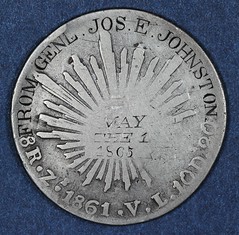
Similar Confederate Treasury coins with engravings attesting to their provenance are called Davis Flight medals, as discussed in previous issues. -Editor
Confederate Numismatica author Peter Bertam writes:
"WOW! Gen'l S D Lee's original Davis Flight Medal!!' What an absolute treasure! I'll add the coin to my list of Davis Flight Medals. Much appreciated."
To read earlier E-Sylum articles, see:
QUERY: ENGRAVED CONFEDERATE CAMP MARION COIN INFO SOUGHT
(http://www.coinbooks.org/esylum_v17n13a15.html)
MORE ON ENGRAVED CONFEDERATE DAVIS FLIGHT MEDALS
(http://www.coinbooks.org/esylum_v17n15a21.html)
ALAN WEINBERG ON DAVIS FLIGHT MEDALS
(http://www.coinbooks.org/esylum_v17n16a20.html)
PETER BERTRAM ON DAVIS FLIGHT MEDALS
(http://www.coinbooks.org/esylum_v17n17a12.html)
MORE ON KENT WHITING'S DAVIS FLIGHT MEDAL
(http://www.coinbooks.org/esylum_v17n47a14.html)
THE LAST DAYS OF THE CONFEDERATE TREASURY
(http://www.coinbooks.org/esylum_v17n48a10.html)
MAJOR GENERAL BROWN'S DAVIS FLIGHT MEDAL
(https://www.coinbooks.org/v20/esylum_v20n27a12.html)
NEW PUPPY FINDS GOLD SOVEREIGN CACHE
David Pickup passed along this great story of the new puppy who dug up a cache of gold coins. Thanks! -Editor
A family's new truffle-hunting puppy is already worth its weight in gold after digging up 15 sovereign coins worth £6,000 on its first walk.
Adam Clark, 51, bought Ollie, a lagotto romagnolo, as a surprise for his daughter Alicia, nine, last month.
The breed is notorious for digging - especially for truffles - and on March 30 the young dog stumbled upon a small fortune during its first walk around the local fields.
To Mr Clark's delight and utter disbelief, Ollie instinctively dug up a total of 15 gold sovereign pieces likely dating back to the nineteenth century.
Mr Clark, from Blackpool, Lancashire, said: 'When we got him we thought he seemed special.
'Alicia was over the moon and we couldn't wait to take him out for his first walk around the gala fields.
'We'd literally been walking for around ten minutes when Ollie suddenly stopped and started frantically digging away at the soil.
To read the complete article, see:
Worth its weight in gold! Family's new truffle-hunting puppy digs up 15 sovereign coins worth £6,000 on its FIRST walk
(https://www.dailymail.co.uk/news/article-10735159/Familys-new-truffle-hunting-puppy-digs-15-sovereign-coins-worth-6-000-walk.html)
THE 2022 AUSTRALIAN MINT HONEYBEE COIN
Hooray for honeybees! When I read this headline on a story about a coin picturing a honeybee - "Is this really the species we should celebrate?" I thought, who could have anything against a honeybee? It turns out, the author was lamenting the introduction of the honeybee to Australia as an invasive species. -Editor
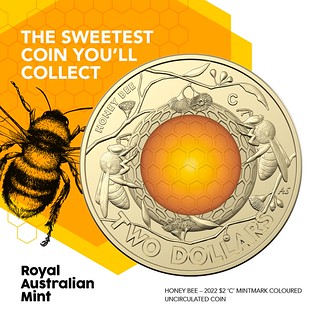 The coin was released to mark the bicentenary of Australia's honey bee industry. Honeybees were introduced to Australia by early European settlers and there are now about 530,000 managed honeybee colonies.
The coin was released to mark the bicentenary of Australia's honey bee industry. Honeybees were introduced to Australia by early European settlers and there are now about 530,000 managed honeybee colonies.
The commercial honeybee industry provides pollination services to a range of crops, as well as honey and beeswax products.
But the industry comes with costs as well as benefits. The introduced honeybee can escape managed hives to establish feral populations, which affect native species.
Honeybees can take over large tree hollows to build new colonies, potentially displacing native species. Tree hollows can take many decades to form and bee colonies occupy hollows for a long time – so this is a long-term problem for native bees.
Many other native species also rely on tree hollows for shelter and breeding, and are likely to be affected by competition from honeybees. They include at least 20% of birds including threatened species such as the superb parrot and glossy black cockatoo, as well as a range of native mammals and marsupials.
Honeybees, both feral and managed, also compete with native species for nectar and pollen in flowers. Research has shown honeybees often remove 80% or more of floral resources produced.
This is not the first time an Australian coin has commemorated an invasive species. This year, the Perth Mint released a collectable $100 coin to celebrate Australian brumbies – or feral horses – which it described as national icons seen by many as symbolic of our national character
.
Brumbies have long been an object of affection in Australian culture, including romanticised depictions in movies and poems such as Banjo Patterson's The Man From Snowy River.
In recent years this has translated into a campaign to protect feral horse populations, which can wreak havoc in fragile ecosystems such as NSW's Kosciuszko National Park.
When species are featured on a coin, it elevates their profile, engenders public affection and, according to the Royal Australian Mint, helps tell the stories of Australia
.
Australia's native species are tenacious – often the underdog fighting for a fair go in a harsh environment. Surely that's a story also worth telling.
In response to this article, chair of the Australian Honey Bee Industry Council, Trevor Weatherhead, said the Royal Australian Mint took the opportunity, after representation from our industry, to highlight a very important pollinator that makes an enormous contribution to the Australian economy […] If people want other pollinators to be on a coin then they can approach the mint to do so.
Mind you, the honeybee was introduced two centuries ago. But once an invasive species, always an invasive species, I guess. Hooray for all the pollinators! Who gets their coin next? -Editor
To read the complete article, see:
A new $2 coin features the introduced honeybee. Is this really the species we should celebrate?
(https://theconversation.com/a-new-2-coin-features-the-introduced-honeybee-is-this-really-the-species-we-should-celebrate-181089)
THE BOOK BAZARRE
PHYSICAL CRYPTOCURRENCY PREMIUMS
We don't generally discuss grading or pricing, but this Stack's Bowers press release highlights an interesting numismatic aspect of their recent sales of physical crypto-coins: significant premiums over the value of the cryptocurrency contained within. -Editor
Over $500,000 in physical bitcoins and other cryptocurrency was sold by Stack's Bowers
Galleries in their Spring 2022 Showcase Auction, contributing to nearly $37 million in overall prices realized for the
sale—a 60% increase above the pre-sale estimate. The Stack's Bowers Galleries Spring 2022 sale was largest and
most diverse offering of physical cryptocurrency ever by a major auction house, confirming Stack's Bowers
Galleries as a market leader among today's expanding community of collectors. The firm first presented this
category at auction in November 2021 when a 500% premium was realized by a Lealana 0.1 Bitcoin. Strong
premiums continued to be earned throughout this recent offering, far exceeding premiums reported in any other sale
venue. The Bitcoin price at the time of the April sale was approximately $45,000 and all premiums to follow reflect
the percentage earned above the underlying face value
of the cryptocurrency.
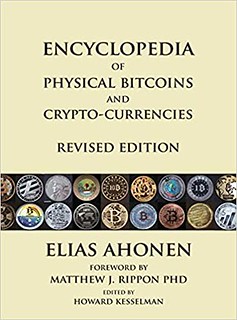 The sale featured an array of Bitcoin and Litecoin from the popular Lealana and Casascius series, all certified and
encapsulated by PCGS. Also included were several unloaded and redeemed coins that remain very popular as
keepsakes of this exciting technology. The Casascius coins were highlighted by a 2013 1 BTC that earned a near
50% premium at $66,000 and a 2013 0.5 BTC that sold for a 40% premium at $31,200. These were purchased
directly from Mike Caldwell, the creator of the series, as part of original rolls of coins. They were accompanied by
two of the historic 2011 Casascius Error 1 Bitcoin pieces, which are important as the first funded physical bitcoin
ever produced, according to researcher Elias Ahonen's Encyclopedia of Physical Bitcoins and other Crypto-Currencies. Included in this pair was a MS-66 (PCGS) that realized a premium of over 70% at $78,000, ranking as the sole finest of just five at PCGS.
The sale featured an array of Bitcoin and Litecoin from the popular Lealana and Casascius series, all certified and
encapsulated by PCGS. Also included were several unloaded and redeemed coins that remain very popular as
keepsakes of this exciting technology. The Casascius coins were highlighted by a 2013 1 BTC that earned a near
50% premium at $66,000 and a 2013 0.5 BTC that sold for a 40% premium at $31,200. These were purchased
directly from Mike Caldwell, the creator of the series, as part of original rolls of coins. They were accompanied by
two of the historic 2011 Casascius Error 1 Bitcoin pieces, which are important as the first funded physical bitcoin
ever produced, according to researcher Elias Ahonen's Encyclopedia of Physical Bitcoins and other Crypto-Currencies. Included in this pair was a MS-66 (PCGS) that realized a premium of over 70% at $78,000, ranking as the sole finest of just five at PCGS.
The Lealana coins were spotlighted by a scarce four-coin set of silver 2013 Lealana bitcoins, offered individually in consecutive lots. Each coin is marked with the serial number 24, making it one of the earliest sets issued by Lealana creator Noah Luis, aka "smoothie." The set was highlighted by an important gold-plated 1 BTC graded Proof-69 Deep Cameo (PCGS) that brought a 140% premium of $108,000. This historic coin is described by specialist Elias Ahonen as "perhaps the most visually interesting" issue from this series.
Also included in the set was a 0.1 BTC graded Proof-70 Deep Cameo (PCGS) that sold for a 245% premium at $15,600, a 0.25 BTC graded Proof-69 Deep Cameo (PCGS) that earned a 240% premium at $38,400, and a 0.5 BTC graded Proof-70 Deep Cameo (PCGS) that realized a 190% premium at $66,000. A similarly matched set of 2013 Lealana litecoins was also featured, highlighted by a 10 LTC Proof-68 Deep Cameo (PCGS) that brought a 530% premium at $7,800.
With such significant premiums and over a half million in prices realized, the Stacks' Bowers Galleries Spring 2022 Auction will be forever remembered as a historic offering of physical cryptocurrency.
So yeah, we're all kicking ourselves for not buying a roll or two when we had the chance. -Editor
To read the earlier E-Sylum articles, see:
BITCOINS GO FROM VIRTUAL TO PHYSICAL
(https://www.coinbooks.org/esylum_v14n45a22.html)
U.S. GOVERNMENT SHUTS DOWN PHYSICAL BITCOIN MINTER
(https://www.coinbooks.org/esylum_v16n51a14.html)
PHYSICAL BITCOINS, BOGGS, AND EXPENSIVE PIZZA
(https://www.coinbooks.org/v24/esylum_v24n42a07.html)
2013 SILVER LEALANA 0.1 BITCOIN OFFERED
(https://www.coinbooks.org/v24/esylum_v24n46a20.html)
NEW BOOK: ENCYCLOPEDIA OF PHYSICAL BITCOINS
(https://www.coinbooks.org/v24/esylum_v24n45a05.html)
THE ENCASED POSTAGE STAMP
An article by Frank Clark in the Heritage April 26, 2022 Currency News email newsletter discusses one of my favorite topics: U.S. Encased Postage Stamps. -Editor
A Collectibles Convergence: The Encased Postage Stamp
Encased Postage is one category of collectibles where coin, stamp, and paper money collecting all intersect. Major references for all three of these collectible categories list Encased Postage. The fun and fascinating nature of these small wonders belies the historical hardship in the time of their origin.
United States Encased Postage came into being as a "money of necessity" at about the same time and for many of the same reasons that ushered in the First Issue of Fractional Currency. The increased demand for metals and the economic uncertainty brought on by the Civil War caused a coin shortage due to severe hoarding of small change and resulted in the creation of this marvelous collectible. The coin hoarding spurred by the Civil War grew so problematic that by February 1862, specie brokers were quoting a premium upwards of 4.75% for gold and silver.
By the time Jefferson Davis became President of the Confederate States of America on February 22, 1862, the gold and silver premium had grown to nearly 10%. At this point, even the lowly copper-nickel cents were withdrawn from circulation by the populace.
The Philadelphia Mint proceeded to mint more and more copper-nickel cents. The value of the copper-nickel mixture was lower than the more-pure copper cents. Even then, the coins were hoarded in overwhelming proportions. At this point, the public turned to the only available medium at hand and began using postage stamps for their small change needs. Merchants began accepting postage stamps in their transactions since there were few alternatives. As a result, supplies of postage stamps began trading at a premium, which in turn resulted in a shortage of postage stamps to move the mail.
When used for basic financial transactions, postage stamps easily became soiled or stuck to one another. Once damaged, they were useless as postage and useless as small change. This produced a plethora of other expedient ephemera for use in commerce that included paper scrip in small values, low denomination cardboard chits, merchant IOUs, and even small envelopes with advertising on the back used to contain postage stamps.
At this point, entrepreneur and inventor John Gault stepped into the picture. To prevent deterioration of the stamps, Gault's solution was to enclose the postage stamps in a durable metal case with a mica "window," so that the stamp was both visible and protected from damage. Gault's profit came from initially selling the pieces to merchants. The backs of these first encasements were primarily blank save for a patent date and John Gault's name. Gault then hit upon the idea of using the back of the encasements for advertising. At the height of Gault's success, he was being commissioned to provide Encased Postage for merchants who were not retailers and therefore they did not need change. However, the merchants did see the value of advertising on the back of the encasements.
Encased Postage lived a short life as the First Issue of Postage Currency (Fractional Currency) was distributed on September 8, 1862. Available stocks of the diminutive notes quickly ran out. Still, by early 1863, the National Currency Bureau (now the Bureau of Engraving and Printing) was able to print a sufficient quantity of notes so that they circulated freely. Finally, the Post Office cut off the sale of stamps for all but postage use. These two factors signaled the death knell for Encased Postage, which was likely to circulate whenever an economic crisis restricted the regular money supply.
Heritage is pleased to present an advanced collection of Encased Postage of more than 50 pieces to our bidders in our upcoming Signature® Auction on May 4.
To read the complete article, see:
A Collectibles Convergence: The Encased Postage Stamp
(https://movieposters.ha.com/c/newsletter.zx?frame=no&id=6164#collector-a)
NEW GUINEA HEAD TAX TOKENS
The American Tax Token Society (ATTS) has awarded their 2021 Literary Award for Best Newsletter Article to John Phipps for "New Guinea Head Tax Tokens." With permission, we're republishing most of it here. Thanks, and congratulations. -Editor
New Guinea Head Tax Tokens
by John Phipps
As a Tax Token collector, you should always be on the lookout for tax tokens and related material. That is how you find unique and possibly low-cost items to add to your collection. Doing just that, I was looking through the catalog for the Kagin's March 2021 Auction and found a lot in the March 15, Session 4, Hut/Head Tax Token.
The starting bid is $10. Estimated price $100 - $250. The description says it is from 1934-35 Papua New Guinea.
Here is the image from the catalog.
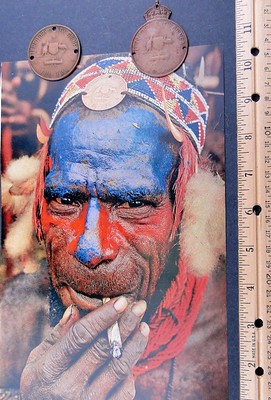 As you can see, the catalog image is very colorful and eye catching! A bidder might be bidding for the photo as much as the tokens!
Well, I thought I would do some further investigation before I decided on bidding. Here is what I discovered. In 1914, Australian/British forces captured German New Guinea. After World War I, in 1920, the League of Nations mandated New Guinea to be governed by Australia. This continued until 1973 when Papua New Guinea gained independence with the only interruption being the Japanese invasion during World War II.
As you can see, the catalog image is very colorful and eye catching! A bidder might be bidding for the photo as much as the tokens!
Well, I thought I would do some further investigation before I decided on bidding. Here is what I discovered. In 1914, Australian/British forces captured German New Guinea. After World War I, in 1920, the League of Nations mandated New Guinea to be governed by Australia. This continued until 1973 when Papua New Guinea gained independence with the only interruption being the Japanese invasion during World War II.
In the 1930s, New Guinea was gearing up mining operations and there was a labor shortage. As a solution to the labor shortage, Australia introduced a system of indentured labor. At the time the British government was recommending that all its colonies abandon such practices. This system required those who did not work to pay an annual 10 shilling Head Tax.
At the time, a typical wage was 5 shillings per month. This pushed many natives into the work force as a matter of economics. The token was to be always on display. Usually, it was worn on a necklace. Failure to have the token on display was imprisonment. That certainly does not look like this token. This one is worn on a headband and says TUL-TUL
on it. I needed to do more research.
In the 1940s, Australia had badges made for LULUAI
(village chiefs) and TUL-TUL
(their assistants). The badges were struck by Amors in Sydney. These badges were worn as part of a headdress and were a sign of authority and pride. As a result, they were highly polished.
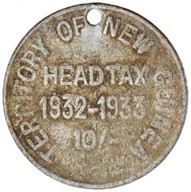 I believe that the Kagin's auction lot is a
I believe that the Kagin's auction lot is a LULUAI
and TUL-TUL
Badge and not a Hut/Head Tax Token.
So, I started searching the internet for images of New Guinea Head Tax Tokens. In an auction by Noble Numismatics Pty. Ltd., on November 26-29, 2013, I found a 1932-1933 Head Tax Token that sold for $90 (hammer). Here is an image from that catalog.
Well, I discovered all this on a Saturday, two weeks before the auction. Kagin's Auctions would not be in the office until Monday, so I had to wait until then to call then. Their response was that they had some sequence errors and were working around the clock to get them corrected. In general, I felt that they knew that they had a lot of cleaning up to do and this was just one of many. Later that Monday, Kagin's Auctions removed the images. It was replaced with, Image Coming Soon.
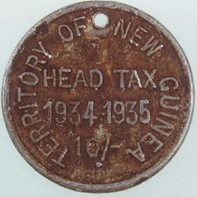 On Friday morning a week before the auction, Kagin's Auction had placed the correct image with the description. Here is the new image. Now, all that is left to do is wait and to decide if I am bidding.
On Friday morning a week before the auction, Kagin's Auction had placed the correct image with the description. Here is the new image. Now, all that is left to do is wait and to decide if I am bidding.
Well, on the day of the auction, the New Guinea Head Tax Token sold for $60 plus 20% buyer's premium plus shipping. I didn't submit a bid. With the pluses
it would have cost me over $100 and although this is an interesting piece my collection is simply fine without it.
THE S.S. REPUBLIC C.Q.D. DISTRESS SIGNAL MEDAL
I missed publishing this Noonan's press release before the sale - it's about an interesting Titanic-related lifesaving medal - it brought £1,700 in the sale. -Editor
LIFESAVING MEDAL AWARDED TO MEMBER OF STAFF ON THE ILL-FATED TITANIC
-Medal awarded three years earlier, and unfortunately the recipient perished on the renowned ship -
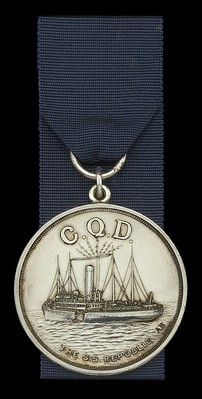 The Life-saving medal awarded to First Class Bedroom Steward
H. Roberts, S.S. Republic, for his assistance in the rescue of over
1,700 lives from the Republic and the Italian liner
The Life-saving medal awarded to First Class Bedroom Steward
H. Roberts, S.S. Republic, for his assistance in the rescue of over
1,700 lives from the Republic and the Italian liner Florida
,
following their collision off Nantucket in January 1909 will be
offered Mayfair-based Dix Noonan Webb in their auction of
Orders, Decorations, Medals and Militaria on Wednesday,
April 20, 2022. Subsequently, Roberts was transfered to the
R.M.S. Titanic and drowned when the ill-fated vessel struck an
iceberg in the North Atlantic on her maiden voyage on the night of
14-15 April 1912, and sank with the loss of over 1,500 lives. The
silver medal is expected to fetch £1,000-1,400.
Hugh Roberts was born in Holyhead (North Wales) in c.1873 and served as a First Class Bedroom Steward in the White Star Line's S.S. Republic. In the early morning of 23 January 1909, the Republic, sailing from New York to Gibraltar, collided with the Italian liner S.S. Florida in fog off the island of Nantucket, Massachusetts. The White Star Line's R.M.S. Baltic responded to the C.Q.D. (distress signal) call sent out by radio. Three passengers died in the collision; the remaining passengers from the Republic were transferred, first to the less-damaged Florida, and then, on her arrival, to the Baltic. The Republic sank the next day whilst under tow to New York. The saloon passengers of the two White Star Liners subscribed to a fund to provide medals to the crews of the three ships involved, in recognition of the fact that they saved more than 1,700 lives. This was the first occasion on which the C.Q.D. distress call had been sent by wireless transmission.
Roberts remained in the employ of the White Star Line, and was aboard the Titanic for her delivery trip from Belfast to Southampton. He signed on again for the Titanic in Southampton on 4 April 1912, giving his last ship as the Baltic, and was employed upon the ill-fated liner's maiden voyage as a first class bedroom steward, with monthly wages of £3 15s.
Oliver Pepys, Associate Director and Medal Auctioneer at Dix Noonan Webb explains: The
Titanic – one of the most infamous ships of all time – sank 110 years ago on April 15, 1912.
Hugh Roberts was a first class bedroom steward aboard the vessel's maiden voyage and sadly
did not survive. However, three years earlier - somewhat ironically, while working onboard
another ship, the S.S. Republic; he had saved someone else's life and for this act of bravery
was rewarded.
He continues: His body was recovered from the ocean by the Mackay-Bennett, and he was
subsequently buried at sea on 23 April 1912. When recovered from the sea he is recorded as
wearing the following clothes: ‘Black Coat; Steward's Cast; two waistcoats; brown and blue
striped pyjamas; black boots; false teeth top jaw' - I wonder where his bottom teeth went!
For more information, see:
https://www.dnw.co.uk/
LOOSE CHANGE: MAY 1, 2022
Here are some additional items in the media this week that may be of interest. -Editor
A Coin World article by Arthur L. Friedberg discusses the Secret Service's review of counterfeit notes in counterfeit holders. -Editor
The contemporary plague of counterfeit coins being made and then placed into counterfeit third-party holders is now affecting rare paper money. Counterfeit notes are being placed in bogus early generation PCGS Currency holders.
A recent example is a case currently being pursued by the U.S. Secret Service involving a Series 1882 $500 gold certificate. The note, identified as Friedberg 1216a, is a blatantly obvious fake, even without close personal examination. Nonetheless, the Secret Service laboratory did its own technical investigation, and based on additional information provided by trade specialists, confirmed this conclusion.
One 1922 $500 gold certificate bearing this very E72108 number has been known since 1993, when it was sold by Dean Oakes. Then, the Gengerke census says, it was sold by Currency Auctions of America in 2000, and then went unsold in a Lyn Knight auction in 2003. After that, Heritage sold it twice, in February 2005 and April 2013. It final recorded appearance was a month later, when it was sold on eBay.
To read the complete article, see:
Secret Service reviewing counterfeit notes in counterfeit holders
(https://www.coinworld.com/news/paper-money/secret-service-reviewing-counterfeit-notes-in-counterfeit-holders)
F. Michael Fazzari published a short but very interesting article about secret marks on coins in Numismatic News. The image is a broken star found on some Capped Bust half dollars. -Editor
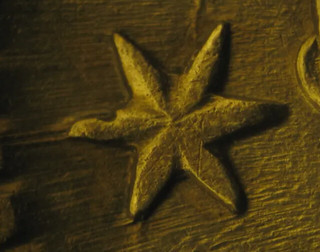 This column is about what I call
This column is about what I call secret marks
on coins. Many of you know that I have been using a stereo microscope to examine coins for most of my adult life. Today, many of you get to see my world
through magnified images posted in online coin forums taken by other collectors. These observations at high powers of magnification have allowed me to identify many things I see again with just a 5X hand lens or my naked eye alone!
Today, I'll write about unusual characteristics found on the dies that were applied at the Mint to serve a specific purpose. Some of these marks occur on a single die while others are on all the dies with a few exceptions. The secret marks
placed on one die are very interesting and, in a few cases, researchers have identified the reason they exist.
To read the complete article, see:
Secret Marks on Coins
(https://www.numismaticnews.net/collecting-101/secret-marks-on-coins)
Ron Guth passed along this CoinsWeekly Who's Who article about John Whitney Walter. Thanks. -Editor
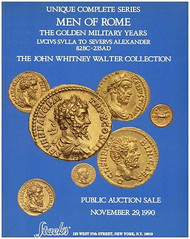 Walter, John Whitney (1934-2018) - CoinsWeekly
John W. Walter was a businessman and a passionate collector. The cousin of President Donald Trump put together a superb collection of Roman aurei, auctioned off as
Walter, John Whitney (1934-2018) - CoinsWeekly
John W. Walter was a businessman and a passionate collector. The cousin of President Donald Trump put together a superb collection of Roman aurei, auctioned off as The Men of Rome
. His collection of early American coins brought him the nickname Mr. 1796
.
To read the complete article, see:
Walter, John Whitney (1934-2018)
(https://coinsweekly.com/whoswho-sammler/walter-john-whitney-1934-2018/)
In a good news story, a paralympian's stolen medals have been recovered and returned. -Editor
San Antonio police say they have arrested the man accused of stealing gold medals out of a USA Paralympian's vehicle.
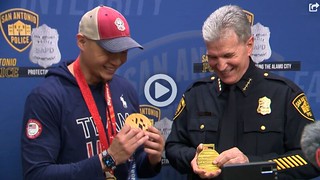 Police Chief William McManus on Wednesday confirmed the arrest on Twitter. McManus said the suspect, identified as 36-year-old Rogelio Solis, was picked up by US Marshals near Roosevelt and I-410 on the city's South Side. He is charged with burglary of a vehicle and theft.
Police Chief William McManus on Wednesday confirmed the arrest on Twitter. McManus said the suspect, identified as 36-year-old Rogelio Solis, was picked up by US Marshals near Roosevelt and I-410 on the city's South Side. He is charged with burglary of a vehicle and theft.
The medals were recovered the following day from a West Side gas station.
Lee thanked the community for its quick response sharing his post and raising awareness about the case.
It is more than just a medal because it's the memories, the people that I connect with, the rehabilitation, the physical therapists, to the doctors to my teammates alongside the guys at rehab with my brothers and sisters in arms,
Lee said.
To read the complete article, see:
Paralympian's stolen medals returned; suspect arrested
(https://www.ksat.com/news/local/2022/04/20/suspect-in-custody-after-usa-paralympians-gold-medals-were-stolen-sapd-chief-says/)
The bibliophiles and punctilious proofreaders among us might enjoy this Vanity Fair piece on the history of the hyphen. If there are multiple books on die varieties of U.S. Large Cents, there might as well be two complete books on the hyphen. -Editor
Among the many books about punctuation, precious few are devoted to a single mark. There's On the Dot,
by the Brothers Humez, which celebrates the period, or full stop; Semicolon,
a thoughtful treatise by Cecelia Watson; and F*ck*ng Apostrophes,
a jewel of a book by Simon Griffin. The hyphen, which may not technically qualify as a punctuation mark, because it operates at the level of the word rather than the sentence—it doesn't make you pause (though it may give you pause)—has inspired not one great book but two: Meet Mr. Hyphen (And Put Him in His Place),
a classic by Edward N. Teall, published in 1937, and Hyphen,
by Pardis Mahdavi, which came out in 2021.
To read the complete article, see:
How to Use (or Not Use) a Hyphen
(https://www.newyorker.com/culture/comma-queen/how-to-use-or-not-use-a-hyphen)

